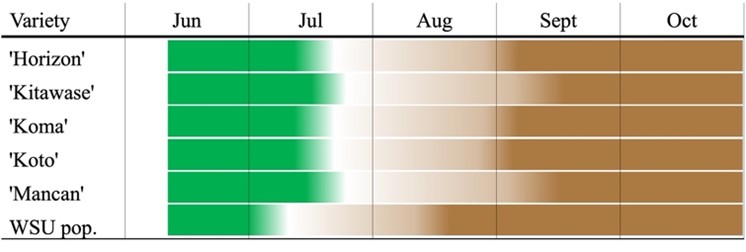Final report for SW21-926
Project Information
Adopting sustainable agricultural practices can increase complexity and management, frequently challenging farm profitability. Crop diversity, a pillar of sustainable agriculture, often relies on rotations that include less profitable crops necessary to disrupt disease and pest cycles. As society demands further strengthening and defining of sustainable practices, markets must also evolve at the same rate to keep farms in business.
To support farmer goals of sustainability and profitability, we propose research and educational outreach projects that will accelerate the development of regional markets for proso millet and buckwheat. These rotational crops intrigue not only Northwest farmers but also our diverse regional stakeholders; processors, maltsters, brewers, millers, bakers, chefs, and schools demand access to these crops. Our stakeholders voiced a need for variety recommendations, nutrition and malt quality data, and networking among growers and end users. We had no regionally adapted resources to share.
For two years, we’ve communicated with stakeholders to develop a project that meets their needs. These discussions gave rise to a highly skilled and motivated project team that includes farmers, food and crop scientists, Extension specialists, and market experts. Together, we successfully identified the crops of interest and identified five main objectives:
1) establish a regional baseline for production and end-use quality of millet and buckwheat varieties currently grown in Idaho and Washington by determining their flavor, food functionality, and nutritional quality to bolster marketability via appropriate end-use recommendations;
2) conduct researcher- and farmer-led millet and buckwheat field trials to identify new varieties for the region that improve upon baseline;
3) characterize new millet and buckwheat varieties for flavor, food functionality, and nutritional and malt quality to determine end-use suitability while also developing optimized product formulations for focaccia mix, pancake mix, and children’s breakfast bar;
4) conduct a market assessment for regionally produced and processed millet and buckwheat with consumer surveys, school district questionnaires, and stakeholder interviews; and
5) use outreach, education, and networking tools to support supply chain development and product awareness among stakeholders to build consumer demand, grower interest, processing capacity, and market connections for millet and buckwheat crops and products.
To ensure crop access, familiarity, and adoption, our project uniquely engages producers and stakeholders along the entire supply chain in collaboration. We will devote much of our project resources to on-farm trialing to not only identify regional differences in variety selection but also to boost farmer confidence in the crops. Stakeholders guided our project target end uses to represent products already in production, and enthusiastically support optimizing product formulations to showcase inclusion of regionally produced millet and buckwheat in value-added products. Our educational outreach is focused on developing lasting relationships and exchanging information throughout the supply chain to support the production and processing of these crops. Our project has the potential, in the short timeframe of three years, to establish a cohort of 20 growers equipped with appropriate varieties of millet and buckwheat to satisfy the cohort of over 20 regional end-use stakeholders who have expressed a demand for the crops.
1) Establish a regional baseline for production and end-use quality of millet and buckwheat varieties currently grown in Idaho and Washington by determining their flavor, food functionality, and nutritional quality to bolster marketability via appropriate end-use recommendations;
2) Conduct researcher- and farmer-led millet and buckwheat field trials to identify new varieties for the region that improve upon baseline;
3) Characterize new millet and buckwheat varieties for flavor, food functionality, and nutritional and malt quality to determine end-use suitability while also developing optimized product formulations for focaccia mix, pancake mix, and children’s breakfast bar;
4) Conduct a market assessment for regionally produced and processed millet and buckwheat with consumer surveys, school district questionnaires, and stakeholder interviews; and
5) Use outreach, education, and networking tools to support supply chain development and product awareness among stakeholders to build consumer demand, grower interest, processing capacity, and market connections for millet and buckwheat crops and products.
Please see the attached Gantt chart. WSARE20_Murphy_ProjectTimeline_Gantt
Cooperators
- - Producer
- - Technical Advisor
- - Technical Advisor
- - Technical Advisor
- - Technical Advisor
- - Producer
- - Producer
- - Producer
- - Producer
- - Producer
- - Producer
- - Producer
- - Producer
- - Producer
- - Producer
- - Producer
- - Producer
- - Producer
- - Producer
- - Producer
- - Producer
- - Producer
- - Producer
Research
1) a regional baseline for production and end-use quality of proso millet and buckwheat varieties currently grown in Idaho and Washington will determine differences in flavor, food functionality, and nutritional quality and will establish categories for appropriate end-uses;
2) researcher- and farmer-led proso millet and buckwheat field trials will determine differences in agronomic performance among varieties across the region;
3) new proso millet and buckwheat varieties will differ in flavor, food functionality, and nutritional and malt quality. Data will determine end-use suitability and guide the development of optimized product formulations for focaccia mix, pancake mix, and children’s breakfast bar; and
4) a market assessment will determine stakeholder preferences for regionally produced and processed proso millet and buckwheat.
Objective 1: Establish a regional baseline for production and end-use quality of millet and buckwheat varieties currently grown in Idaho and Washington by determining their flavor, food functionality, and nutritional quality to bolster marketability via appropriate end-use recommendations (Year 1).
In Year 1, we will assess regional millet and buckwheat production and end-use to establish baseline information on agronomic and end-use performance and to inform improvement strategies. We will map commercial millet and buckwheat production and gather quantitative data (acreage, variety, yield, end-use). We will collect representative grain samples from commercial growers and analyze them as outlined in Objective 3. We will conduct producer interviews at the beginning and end of the project to document producer needs and enable evaluation and impact assessment.
In the following research and education objectives, we will show how we will assess flavor, food functionality, and nutritional quality data to identify optimal end uses for each crop and variety grown. We will work with our producer-collaborators and stakeholders to develop reliable food processing methods to bring these crops and products to market (Objective 3). For example, a producer-collaborator-grown millet crop would be preliminarily evaluated, milled, and then used in products developed with a collaborating stakeholder and Dr. Ganjyal’s lab. Expert sensory panels, consisting of research team members and stakeholder-collaborators, will be used to provide focused feedback that informs the optimization of product formulations (Objective 3). Panelists will complete a questionnaire. Later in the project, consumer acceptability and preferences will be crowd-sourced at outreach events using rapid response surveys at booths with taste-testing activities (Objective 5.4).
Objective 2: Conduct researcher- and farmer-led millet and buckwheat field trials to identify new varieties for the region that improve upon baseline (Years 1-2).
The project aims to select new millet and buckwheat varieties that improve upon baseline agronomics, flavor, food functionality, and nutritional quality. Varieties will be assessed with a mother and baby trial (MBT) design that captures regional adaptability. Most commonly used in participatory plant breeding, the MBT approach links researcher-led “mother” trials, where all crop factors are evaluated in a replicated design, to farmer-led “baby” trials (not replicated on farm but replicated across farms) to capture diverse management practices and environmental conditions [21].
MBT locations will span temperature and precipitation regimes in Western WA/Northern OR (buckwheat) and Eastern WA/Idaho Panhandle/Northern OR (millet). Buckwheat sites will have varied planting times as well as precipitation and temperature regimes. The buckwheat mother trial site will be located at the 78th St. Heritage Farm in Vancouver, WA, typified by a Willamette Valley regional climate with slightly higher in-season temperatures and lower precipitation than most confirmed buckwheat baby trial sites located in more maritime regions of the NW. The millet mother trial will occur at the Spillman Research Farm in Pullman, WA; the site receives 21-in. mean annual precipitation (MAP). Baby trials will be located within 260 miles of Pullman in WA, ID, and OR, with MAP ranging from 11-in to 24-in. We will identify additional baby trial hosts in cooperation with Shepherd’s Grain, a group with extensive farmer networks in the Inland Northwest.
One mother trial will be planted for each crop species (Years 1-2); a researcher-led randomized and replicated variety trial of millet in Eastern WA (7 varieties) and buckwheat in Southwest WA (6 varieties) will each. The mother trials will include varieties identified in Objective 1, lesser known commercially available varieties, and breeding populations developed in Washington state. We will determine key traits of interest for each crop with the producer interview. During the proposal development, growers identified weed suppression, ground cover, and a short growing season as important traits for buckwheat and millet in their rotation. Evaluated traits will include percent emergence, days to canopy closure, disease incidence/severity, days to maturity, plant height, and yield.
A sub-set of varieties will be grown across a range of environments in non-replicated, farmer-led, on-farm baby trials (Years 1-2; 1-4 varieties, plus a control variety) per crop to determine variety performance across environments and capture farmers’ perceptions and acceptance of new varieties. The control variety will be replicated at each baby trial. The host farmer will determine the size of a baby trial and the number of entries at each trial. Replication of varieties across farms will increase statistical power for assessing variety differences across locations. We will analyze data among baby trials if more than three growers are assigned more than one of the same variety or if growers elect to replicate within their farms. We will encourage participating farmers to plant field-scale experimental plots (> 0.25 acres) to effectively assess variety performance in their system. Large plot sizes will capture the heterogeneity across a field, which helps improve inference when replication is otherwise lacking. Host farmers will provide qualitative data (e.g., vigor, overall acceptance, production challenges) and quantitative data (e.g., emergence, canopy development, yield).
By using both replicated trials (“mother”) and non-replicated trials (“baby”), the MBT experimental design allows flexibility in analysis when using a mixed-effects model. We can: (1) determine the correlation between variety performance on-farm (baby trial) and variety performance on-station (mother trial); (2) measure variety reliability using the probability it will perform above or below the mean; and (3) conduct pairwise comparisons of varieties. If a variety is not replicated across farms and is therefore not well represented across the region, fewer inferences can be made [22]. However, these data remain critical to the project because they inform future variety selection decisions by farmers. Additionally, the qualitative data provided by farmers will be included in our publications, with permission.
Seed produced in MBTs will be used to develop product formulations and for nutritional quality and food functionality assessments (Objective 3). The remaining baby trial seed will be incorporated into products by stakeholder collaborators, used for bird seed by Global Harvest Foods (Spokane, WA), and used for on-farm livestock feed.
Objective 3: Characterize new millet and buckwheat varieties for flavor, food functionality, and nutritional and malt quality to determine end-use suitability while also developing optimized product formulations for focaccia mix, pancake mix, and children’s breakfast bar (Years 1-3).
Dr. Murphy’s lab will perform nutritional characterization of millet and buckwheat samples from MBTs. Mineral content will be measured with traditional analytical methods. Data will be used to develop calibrations for high-throughput analysis via near-infrared and x-ray fluorescence spectroscopy. An innovative flatbed scanner phenotyping platform will measure seed size, shape, color, and thousand seed weight.
Physicochemical properties of flours are important for identifying how the flours perform in different food applications. The chemical compositions and functionalities of millet and buckwheat from breeding trials in Objectives 1 and 2 will be measured in Dr. Ganjyal’s laboratory. The chemical compositions to be evaluated include starch, protein, fiber, crude fat, and ash content. These will be determined using standard methods. Flour functional properties to be evaluated include thermal, pasting (rheological), and hydration properties[23,24]. A Differential Scanning Calorimeter will perform thermal analyses. Pasting properties will be analyzed with a Micro-Visco amylograph[24]. The water absorption index and water solubility index will be measured according to published standard methods[23]. All data from the above physicochemical analyses will be used to categorize the millet and buckwheat varieties for processing conditions and potential end-use applications (food and malting/brewing). Using this approach, Dr. Murphy and Dr. Ganjyal have successfully categorized diverse varieties of quinoa into groups based on the most appropriate end use, such as noodles, pasta, sauces, soups, and different baking products, depending on physicochemical analyses[23].
We will select millet and buckwheat varieties based on their chemical composition and functionalities to develop three food product formulations: focaccia mix, pancake mix, and children’s breakfast bar. Formulations will be optimized to maintain or improve flavor, texture, and nutritional quality. WSU Malt Quality Lab (Pullman, WA) will provide consultation and support malting, malt quality analysis, and interpretation of malt quality with sensory data provided through stakeholder-expert panels.
The varieties of millet and buckwheat will be selected and tested in the following specific food applications: a) focaccia mix, b) pancake mix, and c) children’s breakfast bar.
Focaccia mix – Focaccia mix formulations will be tested. Wheat flour + millet flour blends (0, 25, 50, 75, and 100%), as well as wheat flour + buckwheat flour blends (0,25,50,75,100%) will be used as the base formulation for the focaccia mix. A commercial wheat-based focaccia will be used as control.
Pancake mix – The product formulation will be initiated from a commercial pancake mix. The wheat + buckwheat flour blends (0, 25, 50, 75, and 100%) and the wheat + millet flour blends (0, 12.5, 25, 50, and 100%) will be evaluated and compared with the 100% wheat pancake mix as controls.
Children’s breakfast bar – The product formulation will be initiated from a commercial breakfast bar, and up to 40% of buckwheat and millet blend will be used in the formulations. Formulations will be optimized to have millet and buckwheat as leading ingredients and to maintain taste and texture without compromising nutritional value
An expert sensory panel and the research team will evaluate select products from each of the above-mentioned categories for consumer acceptability. The expert sensory panel will include stakeholders who already carry the identified three products, are interested in branching out into those products, or produce other products (e.g., noodles, beer) but will provide informative feedback on the varieties tested. Our stakeholder-collaborators will also use the products as the initial formulations in development of commercial products. For example, a buckwheat variety identified as a high performing flour in quick bread mixes will be 1) sourced from a baby trial (Hidden River Farm); 2) dehulled, kept as whole groats, or milled; and 3) shipped to a stakeholder-collaborator (Snacktivist). Snacktivist will use the buckwheat in the pancake formulation provided by the research team but will also be encouraged to experiment beyond the provided formulation (Figure 3). Snacktivist will complete a questionnaire designed to provide the research team critical information on end-use suitability of the variety and performance of the product formulation. Several of our stakeholder letters of support identify additional members on the expert sensory panel.
Objective 4: Conduct a market assessment for regionally produced and processed millet and buckwheat with consumer surveys, school district questionnaires, and stakeholder interviews.
We worked with WSU’s Division of Governmental Studies and Services (DGSS) to assess marketability for millet and buckwheat products. Over the three-year project period, we : 1) conducted consumer surveys; 2) provided school districts comprehensive questionnaires; and 3) interviewed stakeholders to better understand pricing and feasibility of product incorporation.
Because the majority of consumer groups relative to our project were not easily reached via random sampling, a variety of taste and feedback evaluations was used. Evaluations were promoted among partners such as the Culinary Breeding Network and Organic Seed Alliance and took advantage of events, school taste testings, cafeteria staff personnel, County Fairs, the Washington School Nutrition Association, school food service directors, and their clientele. The targeted audience was reached via our Field to Flavor Showcase events, through school meal programs, an Office of Superintendent of Public Instruction survey, and County Fair pancake breakfasts.
School districts are a key institutional buyer. We developed a comprehensive questionnaire to capture school district requirements such as price ranges, sourcing constraints, product fit, food safety certifications, volumes handled, and volume periodicity. We emailed a link to a web-based survey to all 295 school districts in Washington State.
We conducted a series of in-person interviews with stakeholders and farmers, to gain a better understanding of the potential they see for the grain varieties they tested, feasibility of incorporating millet/buckwheat into their products, and to assist in guiding price estimation. The target audience for this outreach was largely informed by the participating farmer cohort, and convenience and availability of food manufacturing partners, whose time is severely limited. Primarily we worked with Cascade Milling out of Royal City, WA and Camas Country Mill out of Eugene, OR. OSPI school district data and farmer exit surveys was entered, cleaned, and analyzed by the WSU Sustainable Seed Systems Lab and WSU Extension, with support from OSPI and WSU DGSS.
Buckwheat Mother Trials
Field trials were implemented at the proposed trial site in Vancouver, WA in both 2022 and 2023. Both trials were largely implemented as described in the original proposal, with a replicated experimental design using large 640 sq. ft. individual plots (80’ x 8’) to evaluate six varieties of commercially available buckwheat in a western Pacific Northwest (PNW) environment. In 2022, the trials were planted on June 8th and harvested in Late September into early October. In 2023, the trials were planted on June 16th (ongoing). In 2022, buckwheat followed a cover crop of crimson clover that was mowed and incorporated into the soil the third week of May, and was estimated to be able to supply ~60 lbs/ac plant-available N, in-season. In 2023, the same N fertility protocol was used but the crimson clover winter-killed, so 26 lbs/ac of fertilizer N was added along with 30 lbs/ac of K, 13 lbs/ac of S, and 5 lbs/ac of Fe.
Data was collected on yield (total biomass, stand height, and seed), stand counts, progression of crop emergence and flowering, and canopy cover from two 10.76 sq. ft. (1 square meter) subplot sampling areas within each plot. Sub-plot sampling areas were each located ~27 ft inward from each end of a given plot area lengthwise, and positioned centrally ~2.5 ft inward from the plot edges width-wise. For yield, three additional subplots were hand-harvested from each plot in addition to the two main subplots to assure that that buckwheat quantities were ample enough to supply the needs of the processing trial team. All hand-harvested grain samples were threshed and cleaned using a mechanized plot-scale thresher.
The trial used a standard field-scale grain drill (8 ft width with 7-in spacing between openers) for buckwheat seeding (at 50 lbs. seed/acre) and a standard field-scale combine (with a 10 ft header) for harvest after subplots were hand-harvested. This allowed us to additionally gather insight into buckwheat production with regard to using equipment much more comparable to the grower’s experience with this crop (vs. hand-sown/harvested or typical small-scale plot research equipment). All buckwheat that was bulk-harvested with the combine was dried (targeting ~12-13% moisture) and cleaned with a two-screen air screen cleaner, and then supplied to the processing research team.
Statistical analyses used a mixed model with buckwheat variety as a fixed effect, block/replication as a random effect with plot sub-samples as a random nested effect within block/replication, and an alpha value of p≥0.10 for ANOVA and pairwise multiple comparisons.
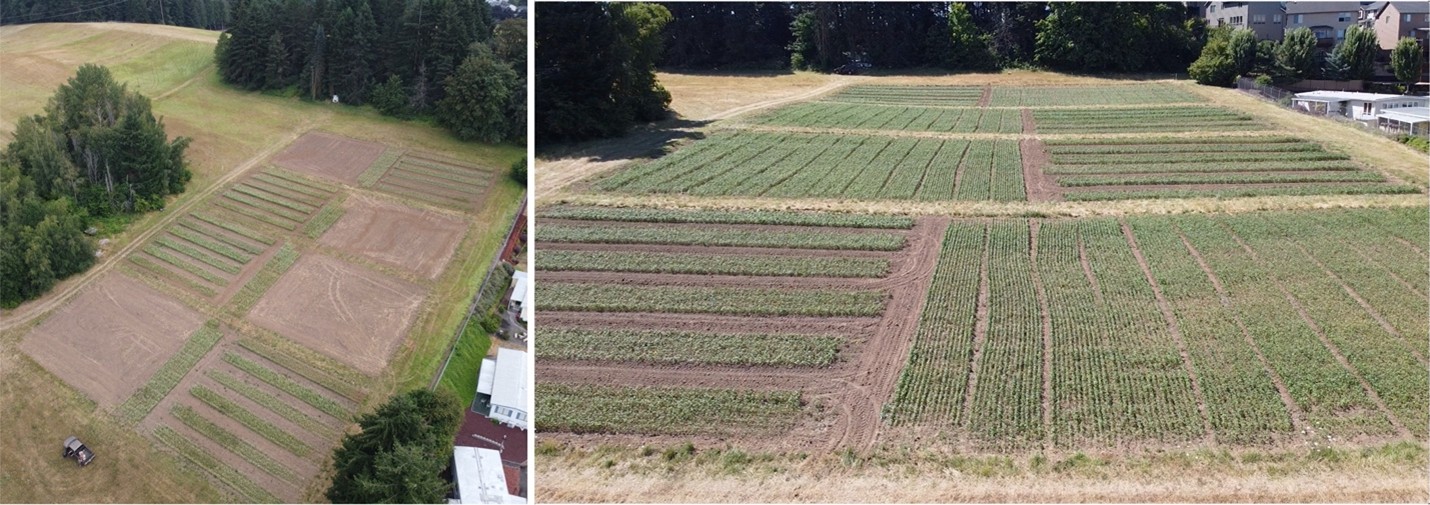
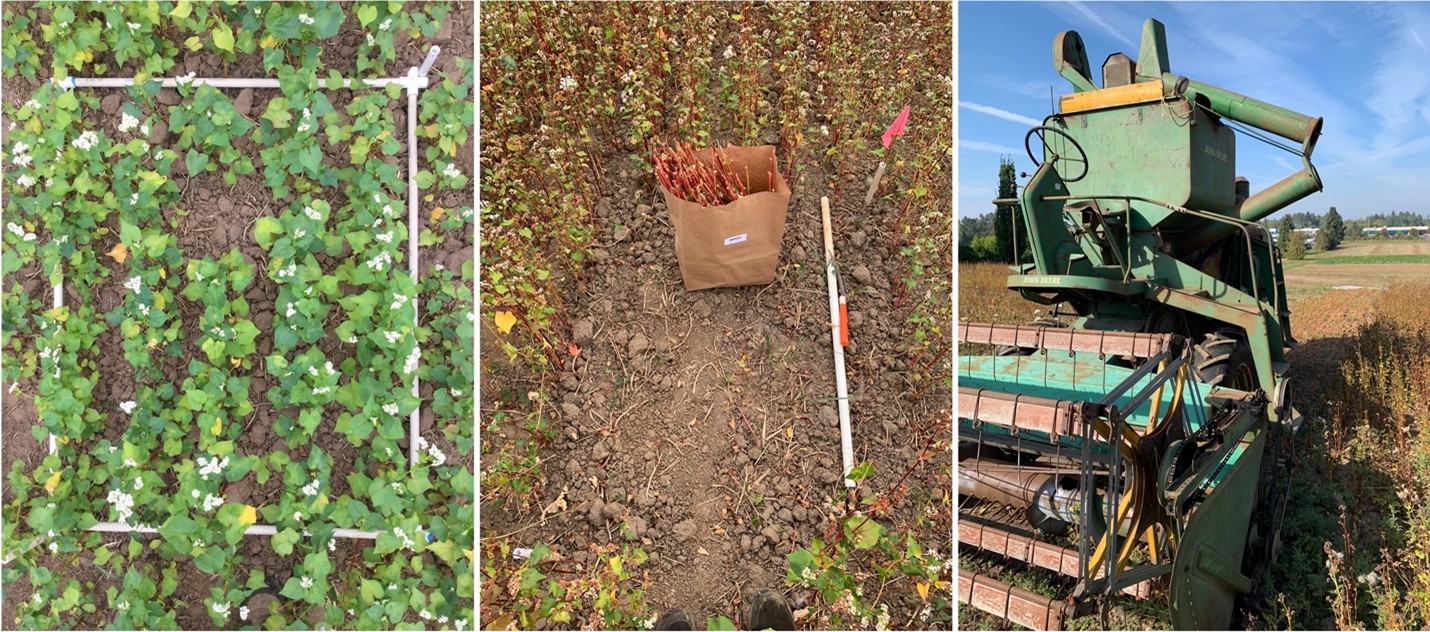
Buckwheat yield appeared highly responsive to water availability, and/or available fertility
Yields of buckwheat seed and biomass appeared to be highly responsive to available fertility and water overall. In 2022, buckwheat yields were substantially lower than in 2023. The 2022 trial growing season was subject to drier growing conditions with 31 days over 85°F and negligible rainfall (0.13”) after buckwheat emergence, compared to 2023 which had only 21 days over 85°F and 1” of rain in late August/early September (Table 1). The latter year was followed by a clear reinvigoration of buckwheat growth and yield from this late season precipitation. Early buckwheat vigor during the 2022 season also appeared to be more attenuated including earlier symptoms of lower leaf chlorosis than observed in 2023. Early season soil water somewhat more abundant in 2022, so this relative lack of early vigor observed may plausibly have been due to fertility differences. In 2022, only a crimson clover green manure was used as the fertility source, whereas in 2023 the buckwheat was given a more targeted application of supplemental fertility.
Table 1. Buckwheat Planting Dates and Subsequent Average Growing Season Weather Conditions in Trial Year
Table 2. Number of Buckwheat Plants of Each Variety per acre, Estimated from Stand Counts
There was evidence of differences in yield parameters between varieties, yet contrasts between varieties were not overtly dramatic (Tables 3, 4 and 5). Overall all the variety ‘Koto’ emerged as one of most robust varieties, with consistently high seed, biomass, and canopy height across both trial years. This occurred despite the variety having a relatively lower plant population (Table 2), with ‘Koto’ expressing strong compensatory plant growth. This trait was evident with the two other black-hulled varieties ‘Koma’ and ‘Horizon’ as well. ‘Horizon’ yielded commendably in both trial years and ‘Koma’ was on-par with ‘Koto’ in 2022.
Amongst the brown-hulled varieties, the experimental WSU population variety was unique with a short-stature but nonetheless producing robust biomass and seed yield in 2022 trials when conditions were less favorable. The brown seeded varieties ‘Mancan’ and ‘Kitawase’ yielded relatively poorly in the 2022 trial year, and then more favorably in the 2023 trial year, with ‘Kitawase’ surpassing seed yields of the WSU variety. These differential yield responses on likely had to do with the more austere growing conditions in 2022, where the relatively later-flowering, later-maturing (Table 6) ‘Mancan’ and ‘Kitawase’ varieties were observed to have been notably senescent during seed fill later in the growing season. The WSU variety, in contrast, flowered a week or more earlier than all the other varieties, which helped to assure that a portion of seed set occurred before resources became more constrained later in the season. The WSU variety also uniquely had an ongoing, prolonged flowering season. It was observed to continue flowering even after the other varieties’ flowering appeared to be declining, and this would happen despite being the variety that was consistently the first to flower. Theoretically this characteristic would allow the plants to continue amassing seed yield late into the season, long after the first set of seeds had already matured. This trait appeared to be evident in the yields from the combine harvests in 2022 (not shown). In this year, the remaining plot plantings of WSU variety was harvested several weeks after all the small subsamples had been hand harvested from the plots, and the WSU variety yielded 124-164% more seed than any other variety.
Table 3. Buckwheat Mother Trial Average Seed Yields for 2022, 2023 Trial Years and Averages Across Both Trial Years
Table 4. Average Total Buckwheat Biomass Yields for 2022, 2023 Mother Trial Years and Averages Across both Trial Years
Table 5. Average Canopy Heights 2022, 2023 Mother Trial Years and Averages Across both Trial Years
Table 6. Generalized Seasonality of Buckwheat Trial Varieties with Green Colors Indicating Pre-Flowering Stage, White Colors Indicating Flowering Stage, and Brown Colors Indicating Seed Maturation Stage
Buckwheat Baby Trials
Buckwheat field trials were coordinated in western Washington and Oregon at ten farms in 2022 and seven farms in 2023, with an average of four varieties per farm, with each variety grown on average at four locations. Plots for each variety were typically ¼ to 1 acre, though one site (The Evergreen State College Organic Farm) grew plots on only 15-foot x 4-foot prepared beds for student instructional and research purposes. Mancan served as the control and was grown at every location.
Results from farmer trials included the following: 1) an emergence observation, 2) a mid-season plant vigor evaluation, 3) an end-of-season interview, 4) yield data from 1m2 x 1m2 sub-samples across all farms and sites, and 5) buckwheat rate trial examining average (55 lbs live seed per acre) and high (100 lbs live seed per acre) seeding rate treatments. Specific management recommendations were provided to growers regarding seeding date, water management (based on seeding date), fertility, seeding rate and depth, and harvest practices. Based on researcher observations and grower input from end-of-season interviews, the following results and observations were obtained:
Farmer Exit Interview
Overall performance was directly related to stand establishment and vigor
- Buckwheat did very poorly, but it was external conditions. Farmer has grown lots of buckwheat in the past that did just fine. Germ was good and so was early growth. His soil was damaged by being plowed too early, which messed with the soil structure, then it was really hot and dry and he didn’t water it.
- Competition with weeds was an issues, Lambs Quarter especially. Weather was also an issue, and lack of water
- Did not suppress weeds if not vigorous
- Performance was variable, decent overall, best in lowland
- The buckwheat suppressed weeds, but only when it could grow vigorously, had a tough time competing with the wild mustard
- Weeds grew where it didn’t germinate well, the timing was difficult, and this farmer couldn’t get the buckwheat to dry down
- It did suppress weeds, and worked even better when interplanted with the birdsfood trefoil
- Buckwheat suppresses weeds sort of, especially when grown with favas
- Looked good, not excellent. Especially for seeding late around June 15th or so.
- Buckwheat suppressed weeds well: Yes, pretty much. Think it did. Wasn’t too dirty. Had some shade.
- It finds enough moisture to grow unirrigated, provides good shade cover for the soil, and is excellent habitat for pollinators
- No weed pressure, very few weeds germinating by the time he plants, the weed pressure is mostly from winter grasses; no major challenges, OG certified so can’t spray and has some weeds. Does a lot of pre-plant cultivation. Cultivated 3 times before he planted using a finish disk.
Farmers liked the flexibility of the grain, and found ways to experiment with it
- Nice that it could be planted late, but stayed too wet, low input is nice likes that it is not necessary to cultivate the buckwheat
- It was easy to grow, a good green manure to rejuvenate soil, it grew well with birdsfood trefoil
- Buckwheat is versatile and equals pancakes
- Interested in yield data, uses it as a summer cover crop along with fava beans. Plants it early in spring where mid-season crops will go.
Harvesting buckwheat is an impediment
- Harvest was difficult, adjusting the combine correctly was hard, the seed was too fluffy, he had to have the fan speed on the combine turned down
- Timing is difficulty, and this farmer couldn’t get the buckwheat to dry down
- Was supposed to sell it but he couldn’t separate out the weed seeds with his combine so it was unsellable (for this reason has no future market objectives for growing buckwheat)
- Can’t plant it thickly enough to be profitable, when he planted it thickly it lodged and he couldn’t pick it back up with his combine (and this grower has a pick-up combine, the only one with)
- Harvested a little for household use (made pancakes!), and used as food for geese and ducks
- Big seed, looked healthy, good stem, held up good. We were just too late. Would have liked to be able to swatch and pick-up combine, but don’t have pick-up header. Was vigorous, didn’t lodge.
- Got a bag, fed it to the ducks through the winter. The combine bogged down, didn’t have a pick-up header so couldn’t harvest it all. Standing in the field, burnt some of it the other day. Too thick of a stem for the combine to harvest.
- Sells to Ukrainian and Russian population, would sell to that. But didn’t get enough. Was too damp even at harvest. Would have molded. Ropey. Would need to swath it and then use a pick-up header. Swath and dry, hope for 7-8d good dry weather. Bill’s perspective is its so moist around here is hard to dry. Humidity he thinks is a problem. To be consistent.
Identifying a market in advance will be critical
- He might like to grow as bedding hay in the future
- The crop was not harvested, it was worked back into the soil
- Has grown buckwheat for Patagonia in the past, they wanted to make noodles with it but they didn’t. They are very interested tho. Has grown 10 acres for customers/production in the past. He only wants to grow buckwheat as a cover crop unless he can make more money per pound selling it as a specialty item. He had someone come teach him and his crew how to make buckwheat soba noodles
- Wants to plant a larger trial if possible. He would be interested in any culinary varieties that he could sell for a higher price. Would be interested in a Russian culinary variety
Locking in best management practices in advance is critical for such a short-season crop
- Should have watered but ran out of time/didn’t
- Even in unideal conditions for grain, very useful as a summer cover crop, but pay attention to changing conditions
- He hadn’t planned on watering but he did so it would germinate. It was planted so late.
- Plant it somewhere where it can access moisture
- Water was his biggest issue, all the rest was pretty equal
- Will plant earlier, water it, and use manure or fertilizer
- Use fertilizer, don’t overpack when you plant it, water it, if lodging is a concern, plant thinner and use less fertilizer
- Planted on 6/16, normally plants a month earlier. Put the buckwheat in ground that had been worked early and didn’t plant spring cover on it. Did stale seed bed before planting and didn’t have an issue with weeds
- Reed canary grass was its biggest competitor, and not watering it was an issue. This farmer claims the crop needs to be irrigated. Also had trouble planting earlier in the season because of weather.
- [Researcher observation relevant to many farmer comments]: Spring 2022 was cold and wet early, and then dried out fairly rapidly, delaying seeding while also making growth difficult past germination
- Buckwheat won’t take frost, even the most minor frost will be bad
- No, he did not/does not water buckwheat when he grows it (despite late planting date) (Hedlin, 6/16 planting)
- Got planting depth right, his planting grew well, he planted in fertile soil that had been fertilized to grow vegetables
Variety performance varied and did not produce an obvious preference
- Overall germination was good
- No “worse” variety
- Horizon was the most variable, Kitawase did the best, it was competitive with the weeds and didn’t lodge (Hidden River)
- Koma was the worst, it lodged and was hard to harvest but it did smother the weeds
- Mancan performed (Fagerness). It sprouted almost as fast as Horizon, had more mass (he’s using it as a green manure), and didn’t lodge (none of his varieties lodged)
- WSU variety as not as good, maybe yield was the same but he thought it looked more yellow. Also the WSU variety didn’t have the mass and yield that the other varieties had (Fagerness)
- All went well, good emergence, Kitawase was faster (Hedlin)
- None lodged and either Koma or Kitawase was 6-8 inches taller than the others; All came up, all were goo.
- Could grow commercially with a little higher ground. Koma was the best, WSU had a hard time coming up. #3 going from house to road 1-3, with #3 on far side of driveway/gravel road. Was a nice even stand, come up even, could be varying by other factors, but just seemed to do best.
- He like Mancan the best. WSU Pop and Mancan looked the most lush to him. WSU Pop was not as good (the 2nd planting he put in was better). He had no clear favorite, but he liked the ones that were denser/more lush as he was growing it for ground cover
Farmers are interested in specialty markets
- Trying to expand grains/dry goods market. Will sell packaged grains at Farmers Markets, Webstore, CSA and hopefully SWWA Food Hub
Producers had remaining questions
- Is there a difference between indeterminate varieties and determinate varieties?
- Is the indeterminate v determinate a factor in what varieties to grow for culinary purposes?
- Performance of different varieties. Interested in ones that are early, or if there are flavor differences among varieties. Also interest in yield data
Producers had observations
- Buckwheat contamination with wheat/other crops has not been a problem, it’s usually in full bloom when he turns it in, but that anything that regrows is killed by frost. He says he has no issues with buckwheat contamination
- Study up on how they grow it in other places. Find a market for it first. It is easy to grow but hard to sell for a profit
- Make sure can get it in early enough. Grow on a sufficiently dry site.
- Put on some cow manure and chicken manure on this ground. Even if don’t put down, grow on the better ground. Definitely need to swath it. If the summer was really hot, might be able to combine it standing up. If the stem was under 15% moisture he thinks could possibly combine it. Get it on flat, level, not shaded ground, a southern elevation (more heat).
Seed Rate Trials (2023) at Puyallup Research and Extension Center
Seeding rate trials completed on a subset of project varieties (Koto, WSU, Komo, and Mancan) at the WSU Puyallup Research and Extension center in summer 2023 demonstrated that both variety and seeding rate significantly influence buckwheat cover at an important time frame while weeds are competing with the crop during canopy closure. Average stand cover (Figure 1) under the high rate was 90.6% while stand cover under low rate was 70.8%. Regarding variety effect, only Mancan showed significantly lower plant cover (61.3%) than the other varieties (Koto: 88.8%; WSU: 87.3%; and Komo: 85.5%), suggesting significantly greater stand vigor for all test varieties compared to the control.
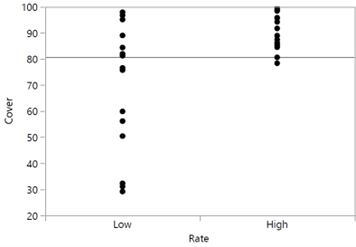
On-farm demonstration trial yield data is presented in tables 7 and 8; yield data from the Puyallup Research and Extension Center trials is reported in Table 9.
Table 7. Year 1 (2022) Baby Trial Buckwheat Yields in On-Farm Demonstration and Evaluation Plots
| Variety | Yield (t/ac) | Locations (#) |
| Horizon | 0.83 | 10 |
| Kitawase | 1.04 | 3 |
| Koma | 0.94 | 6 |
| Koto | 0.61 | 6 |
| Mancan | 0.66 | 12 |
| WSU | 0.77 | 7 |
Table 8. Year 2 (2023) Baby Trial Buckwheat Yields in On-Farm Demonstration and Evaluation Plots*
| Variety | Yield (t/ac) | Locations (#) |
| Horizon | 0.68 | 2 |
| Kitawase | 0.93 | 2 |
| Koma | 0.87 | 2 |
| Koto | 0.55 | 2 |
| Mancan | 0.96 | 2 |
| WSU | 1.84 | 1 |
*Not including 2023 Replicated Puyallup Research and Demonstration Plots
Table 9. Yield and Standard Deviation of 2023 Buckwheat Trials at the Puyallup Research and Extension Center
| Variety | Yield (t/ac) | SD |
| Koma | 1.16 | 0.140162 |
| Koto | 1.43 | 0.110546 |
| Mancan | 1.11 | 0.217502 |
| WSU | 1.40 | 0.290121 |
Buckwheat Market Assessment
Market assessment and supply chain development for this project was supported through partnerships with the Washington State school meals programs, [the Washington School Nutrition Association], and industry partners. The goal with this work was to cultivate school meal programs as a reliable partner and buyer of a value-added buckwheat production, such as buckwheat pancake mix, a muffin mix, breakfast bar, or other.
School Meal Programs
The concept to develop Washington-grown buckwheat products emerged from discussions with Annette Slonim and Nicole Garden, with the WSDA Farm-to-School Program. They indicated the project could dovetail with farm-to-school grant funding to support purchase of Washington-grown products. Programs that could help support purchase of Washington-grown grains for school meal programs include the following:
- WSDA Farm-to-School Purchasing Grant program (https://agr.wa.gov/departments/business-and-marketing-support/farm-to-school-toolkit/grants), which has since had its funding cut
- The OSPI Commodity Food Purchasing grant program, that subsidizes procurement of W-code foods to offset use of potentially more expensive WA-sourced ingredients in processed foods (such as pasta sauce, or products envisioned by this program: focaccia bread, pancake mix, or breakfast bar)
- Local Food for Washington Schools program, which provides funding for sourcing specific products for school meal programs such as bison, salmon, frozen processed vegetables, or potentially one of the products developed for this program)
With this strategy in mind, in 2023 a school meals program survey was developed in collaboration with the WSU Division of Governmental Studies and Services and the Washington Office of Superintendent of Public Instruction (OSPI). It was developed and sent, with the help of Erica Lamson, through OSPI to all 300 school districts in the state, with 224 responding (75 percent response rate). The survey was determined Exempt Human Subjects Research by the WSU Institutional Review Board.
The goal was to determine whole grain products of interest, factors that would influence uptake of Washington-grown grain products, a willingness-to-pay assessment, and interest in continuing to collaborate on new whole grain products for Washington Schools. Feedback identified interest in a range of Washington-grown buckwheat products (Table 10), including dry bread mixes (focaccia, pancakes, muffins), a breakfast bar, dinner rolls, granola, and many others. Interest among school food service programs in three buckwheat products was evaluated, with the intention of guiding product selection (Table 3).
Table 10. Interest Among 224 Washington State School District Food Service Directors* in Three Selected Buckwheat Products
|
Most interested in a pancake mix |
37% |
|
Most interested in a breakfast bar |
70% |
|
Most interested in a focaccia mix |
47% |
|
Number of schools districts interested in being contacted to work together developing and testing a buckwheat-based product |
57 |
*Results are from 2023 survey collaboration between WSU and the Washington Office of Superintendent of Public Instruction. The survey was determined to be Exempt Human Subjects Research by the WSU Institutional Review Board.
Schools reported several factors that are most important in adopting new Washington-grown products into meal programs and emphasized the importance of whole grains and exposure of students to new products through taste-testing (Figure 2).
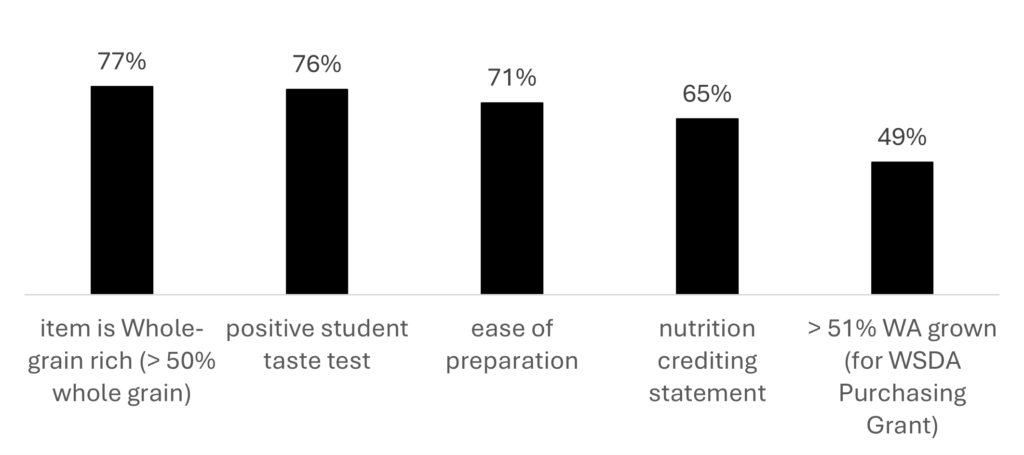
Field to Flavor Showcase with the Washington School Nutrition Association (WSNA)
Finally, the market assessment was supported by an event evaluation completed following a July 2023 “Field to Flavor Showcase” event for members of the WSNA. This evaluation provided direct feedback from WSNA members regarding opportunities to integrate Washington-grown millet and buckwheat products into school meal programs (Table 11).
Table 11. New ideas WSNA attendees gained to integrate into school meal programs, and additional comments regarding the WSNA pre-conference “Field to Flavor Showcase” tour:
|
New ideas |
Comments |
|
I need ideas to help kitchen staff incorporate ingredients. This is my hardest, most challenging step. Kitchen staff are time crunched & often don't want to try new things. |
This was a great pre-conference tour. Well put together and presented. Thank you! |
|
Find a way - recipe for our bakery to add a buckwheat product |
Loved this - so cool! |
|
Incorporating new grains in the menus |
Excellent - thank you! |
|
Community partnerships & crop rotating as sustainability |
I have a lot of knowledge of farm to table in the hospital/restaurant setting & being a gardener/produced for a restaurant - salad greens, radishes, snap peas. Have a lot of understanding of roadblocks & can help give more ideas of what might be more practical to work towards for future |
|
Buckwheat pancakes |
Loved taste testing recipes! They were all delicious! |
|
More education in the school of what I have always wanted to do but now feel it's easier to do. |
It's very educational! |
|
Buckwheat "crepes" made in a sheet pan with poached fruit inside from another member! |
Great event! |
|
Using vegetables when they are most available |
I enjoyed all of this event. Thank you! |
|
Ways to implement buckwheat and millet into our program. |
This was a great pre-conference tour. Well put together and presented. Thank you! |
|
WSDA Harvest of the month |
Loved this - so cool! |
Product Development and Testing
Product Development
Collaboration with Cascade Milling inspired development and testing of a buckwheat pancake recipe, which involved collaborators at InnovationChix (a food science firm that works with Cascade Milling), the WSU Food Science program, and Cascade Milling themselves. Mixes with different levels of buckwheat and sugar were developed. A final pancake formulation with low sugar content and greater than 50% buckwheat was created.

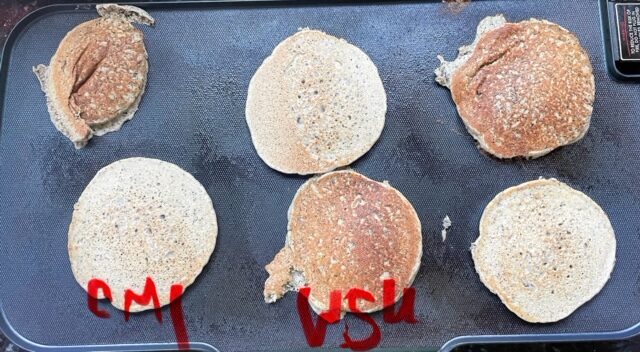
Since the research team was working with a private manufacturer, the formulation was limited to those ingredients that Cascade Milling already used in their pancake mix, with the addition of buckwheat flour. This was due to the companies practice of bulk purchasing ingredients and organic certification. Adding new ingredients at this ‘proof-of-concept’ stage of the research and development cycle was considered not cost effective.
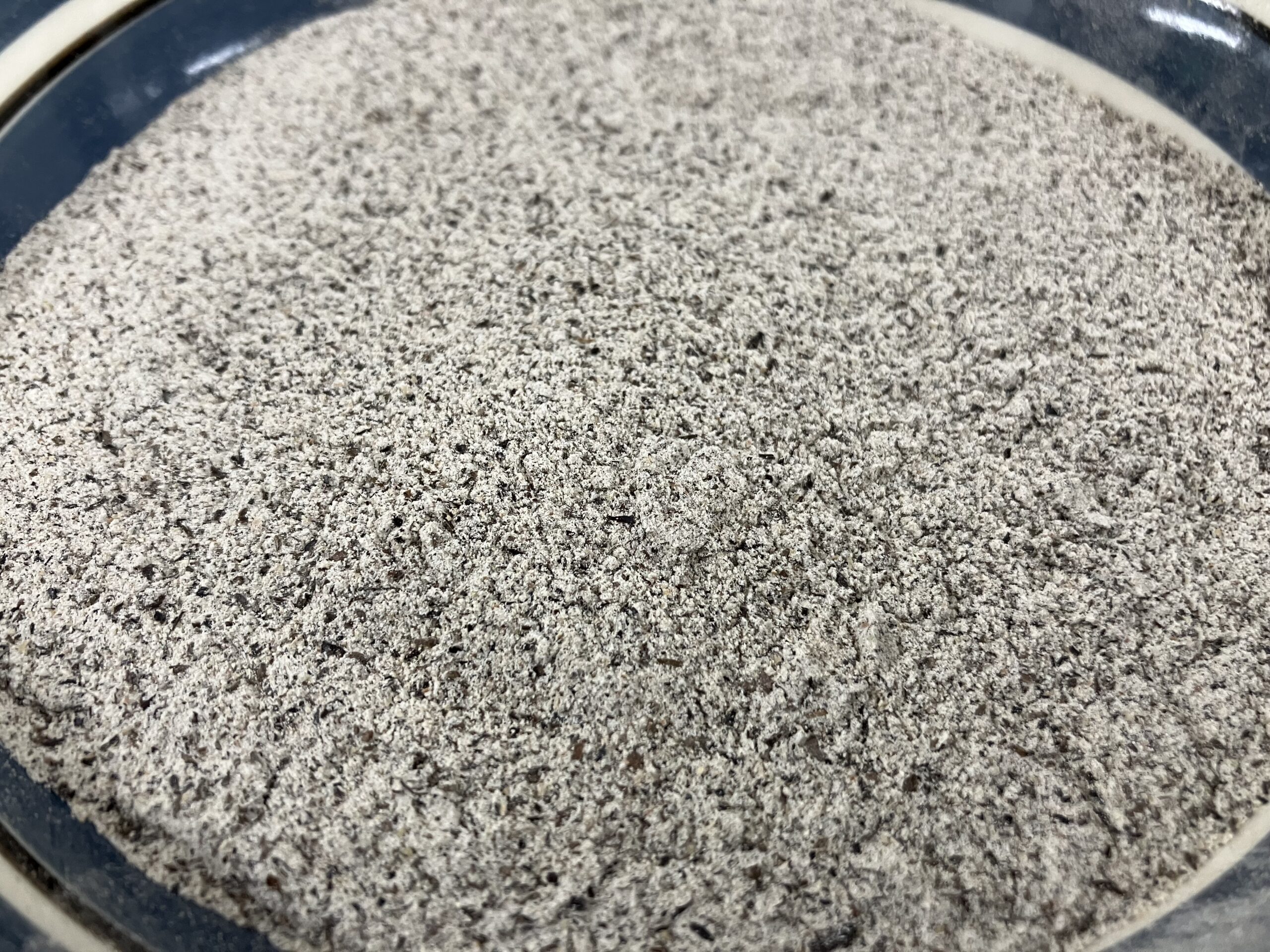
Finally, if ironically, product selection was largely limited to a pancake mix despite it being ranked lowest among products school food programs were interested in. The adage “Beggars Can’t Be Choosers” was fitting when searching among a limited number of willing private food manufacturers. Their time is limited and augmenting an existing product line is more realistic initially than branching out into entirely new directions. That said, this leaves considerable opportunity open for testing and development of additional buckwheat products such as muffin mixes, buckwheat groat granola, or breakfast bars.
To address the problem of making pancakes efficiently in school meal programs, we developed instructions for how to use the mix to make buckwheat pancake “breakfast bars”. This consisted of pouring batches into sheet pans for baking. The flapjack recipe adapted admirably to a new lunchroom life as “bars”.
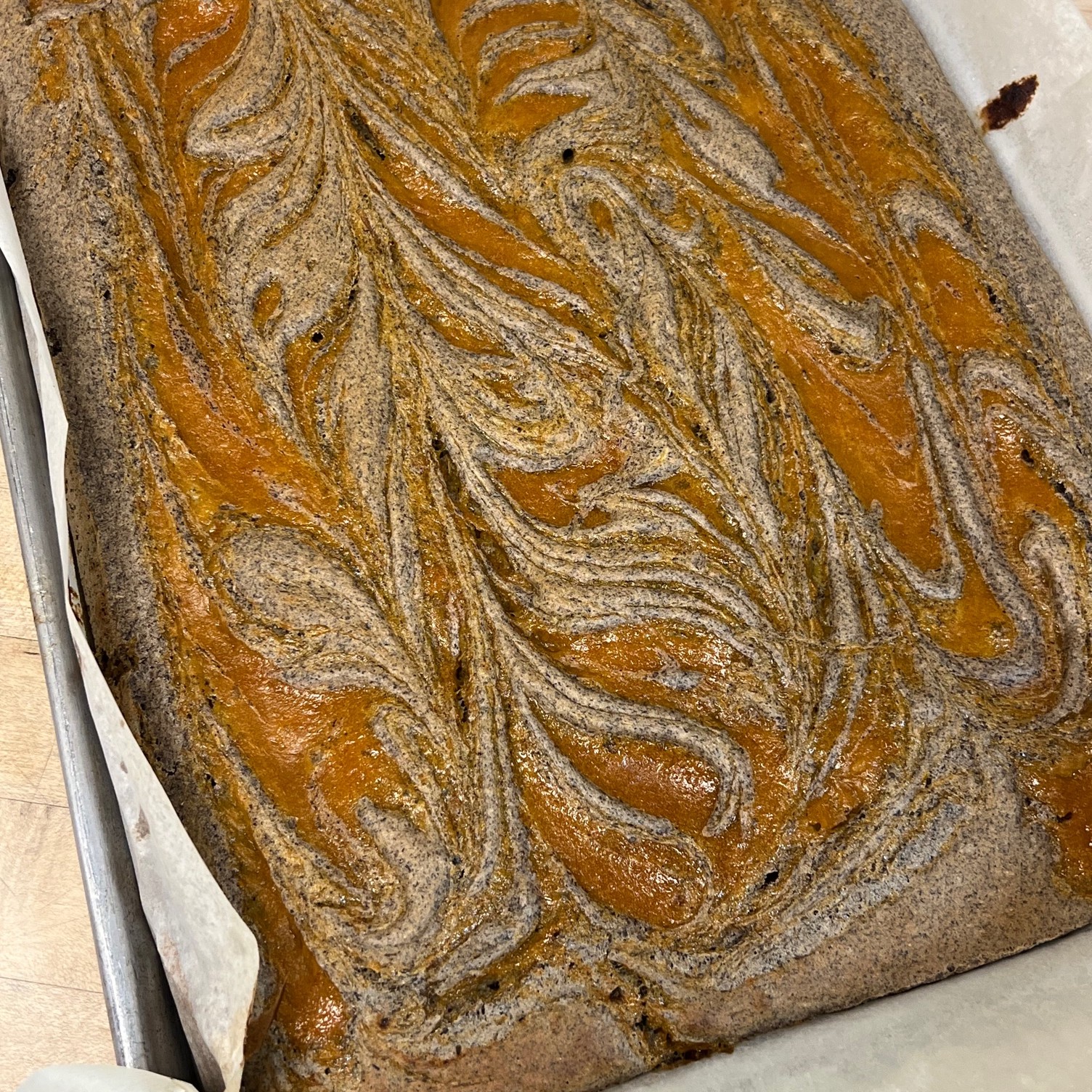
Taste Testing
The product formulation timeline was set to coincide with the October 2024 Taste Washington Month. To prepare and make final adjustments to the receipt, small batches of the pancake mix were taste-tested in classrooms in the Olympia School District at and the Thurston County Fair. Taste testing at the Thurston County Fair occurred at the Board of County Commissioners “Pancake Breakfast” which traditionally is held on Saturday morning of the fair. The mix was also tested in five 5th grade classrooms at Garfield Elementary in the Olympia School District, in collaboration with the SNAP-Ed Program.
Thurston County Fair Buckwheat Pancake Mix Assessment
Development and testing of a buckwheat pancake formulation was aided by testing at a local county fair in Thurston County. County Commissioners typically host a pancake breakfast on the Saturday of fair. Project personnel coordinated with the County Clerk and staff to substitute half of the pre-made commercial pancake mix with a buckwheat pancake mix made from buckwheat grown in the County. County staff, administrators, and Commissioners were enthusiastic about the project, and conducted outreach about the local-made pancake mix, made buttons, and circulated and posted project posters at the event. A short ballot was laid out at tables for participants to fill out. Approximately 30 feedback forms were completed. The primary question asked of this cohort was their willingness to purchase the mix if it was commercially available (Figure 3). This feedback would be particularly useful to private partners on this project, namely Cascade Milling, as an indication of the broader commercial appeal of the mix.

Fair pancake taste-testers were also asked for open-ended qualitative feedback about the pancake mix and provided answers across a variety of age-ranges.

Table 12. Reasons that Thurston County Fair Pancake Breakfast Attendees Would Purchase Buckwheat Pancake Mix if Commercially Available*
|
Age 49: “local and so great! delicious flavor” |
|
Age 59: “best ever” |
|
Age: “sell to restaurants; would buy as gift to give” |
|
Age 81: “tasty pancakes and nutritious” |
|
Age 13: “it’s good” |
|
Age 37: “delicious” |
|
Age 16: “had them at the Thurston County Fair, they were so delicious!” |
|
Age 48: “would love to buy local grains!” |
|
Age 10: because it has a ton of flavor |
|
Age 15: because of all the kinds of pancakes I’ve ever tried, these I would consider some of the best cakes I could get. |
*Approximately 150 people attended the pancake breakfast and 19% provided feedback (n=28).
Elementary School Student Taste Testing
To obtain a direct evaluation of the potential acceptability of the formulated buckwheat pancake mix, project personnel collaborated with a local SNAP-Ed program in Washington State. We conducted a taste test of 85 fifth grade students in a local elementary school. Students were provided with freshly made buckwheat pancake samples. To get an assessment of the pancakes themselves, they were served without butter or syrup. This arguably skewed a "real-life" experience they would get in the school cafeteria, but prevented feedback from being influenced by the flavor of a sweetener and butter. Youth taste testers provided useful qualitative feedback. While the SNAP-Ed program emphasized in advance that students should not “yuck my yum” (share distastes outloud, thus influencing nearby taste testers), some convergence in responses did appear to occur by table.
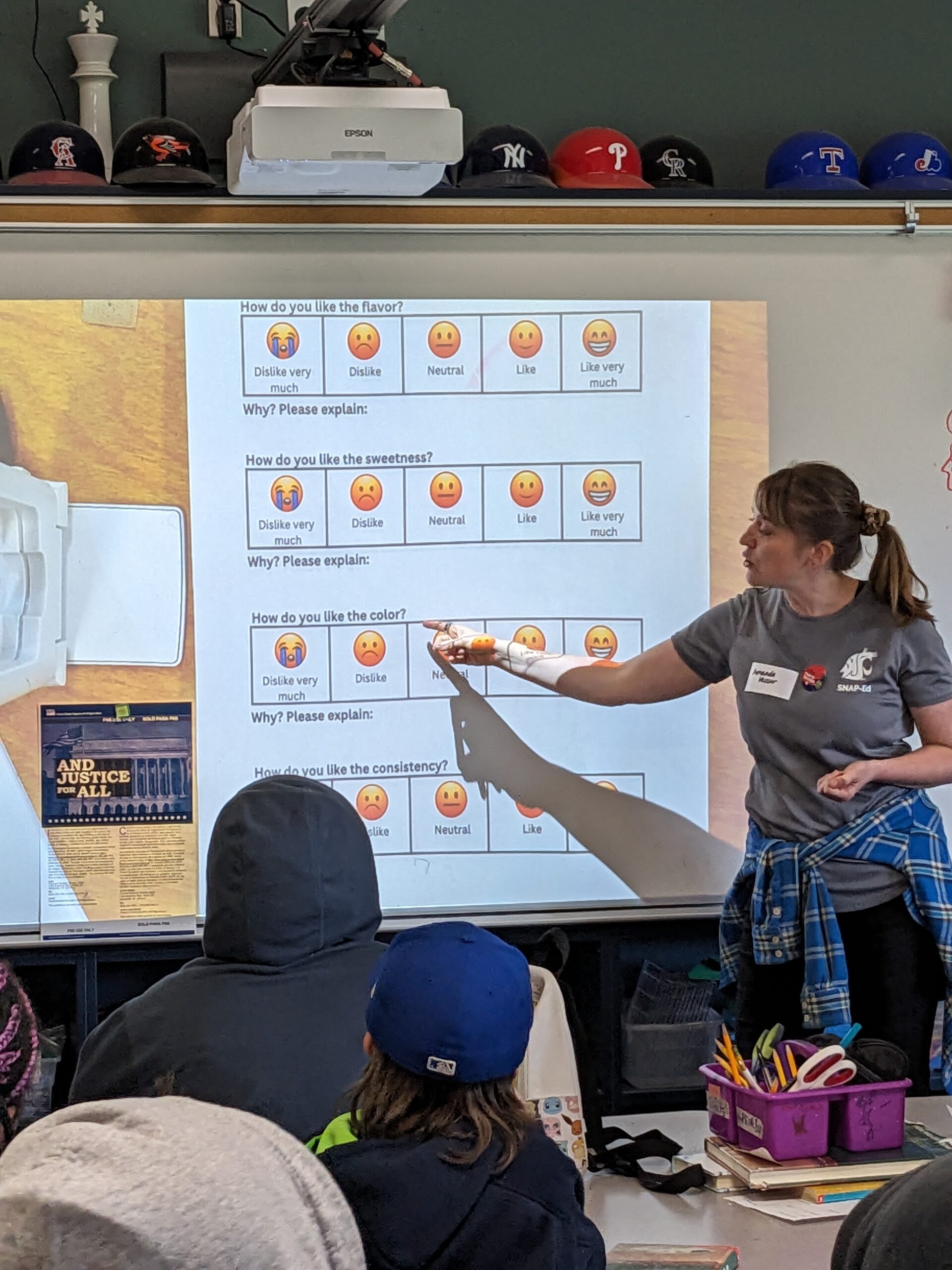
Table 13. Liking Preferences and Rationale for Buckwheat Pancakes Among 5th Grade Students Who Participated in a SNAP-Ed Taste Test
|
Yes |
No |
Neutral |
|
• Delicious, sweet • Good • I like it • I like the sweet with the char • I like it, reminds me of banana bread • I think it tastes a little burnt, but the sweetness is good • I want seconds • It has a solid flavor to it sweet enough to the point where it isn't too sweet • It was good but kinda plain • It's sweet • Really okay actually (tastes like a muffin) • So much flavor • Taste good • Taste kind of sand papery, grainy, stale • Tastes burnt a little but is good • Just how I like it |
• It's not chill...dislike very much because it tastes burnt • It has no flavor • Bitter and dry but decent flavor • It just tastes bad, bland, burnt & too grainy • Burnt • It was bitter and burnt and dry • It was sweet but not super sweet • Taste burnt and like poopoo • Too flowery • Has a soapy after taste, tastes somewhat like banana • No flavor • Very bitter and tasteless • Aftertaste is gross
|
• Somewhat sweet kinda burnt • I don't know • It was not so good, but I like the taste • It was salty! • No explanation • You get that about taste of buckwheat |
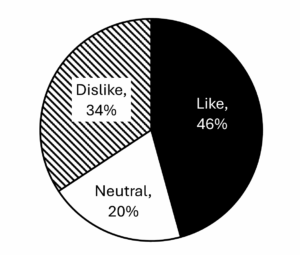
At Scale Production Distribution
Following recipe development and taste testing, a final recipe formulation was established that reduced sugar content somewhat further. Plans were developed to conduct what we called an “at scale” production run, though this was a fraction of Cascade Millings mixing capacity. The WSU Extension program sourced labels, worked with InnovationChix on a nutrition label and whole grain equivalent for sale to school meal programs, compiled essential elements into a label, confirmed availability of packaging for Cascade Milling compatible with their manufacturing line, and coordinated with warehouse personnel and the marketing team to organize the production run.
Buckwheat flour was sourced from Hedlin Farms in the Skagit Valley, a participating farmer in the field trials. Camas Country Mill out of Eugene, Oregon was used for milling, as Cascade Milling is too large of a facility to switch over their wheat milling line for a small run of buckwheat flour. As such, the supply chain was awkward and rather long, but for a small run this was easiest for the partners involved.
In September of 2024, the Cascade Milling batch mixer was used to manufacture 1,700 pounds of the pilot pancake mix. Fifty-pound bags were subsequently shipped to three distribution partners: the SW Washington Food Hub (Chehalis, WA), Linc Foods (Spokane, WA), and Viva Farms (Mt Vernon, WA). From there, mix was distributed for free or for cost-of-delivery by the Food Hub partners to food districts in their customer base.
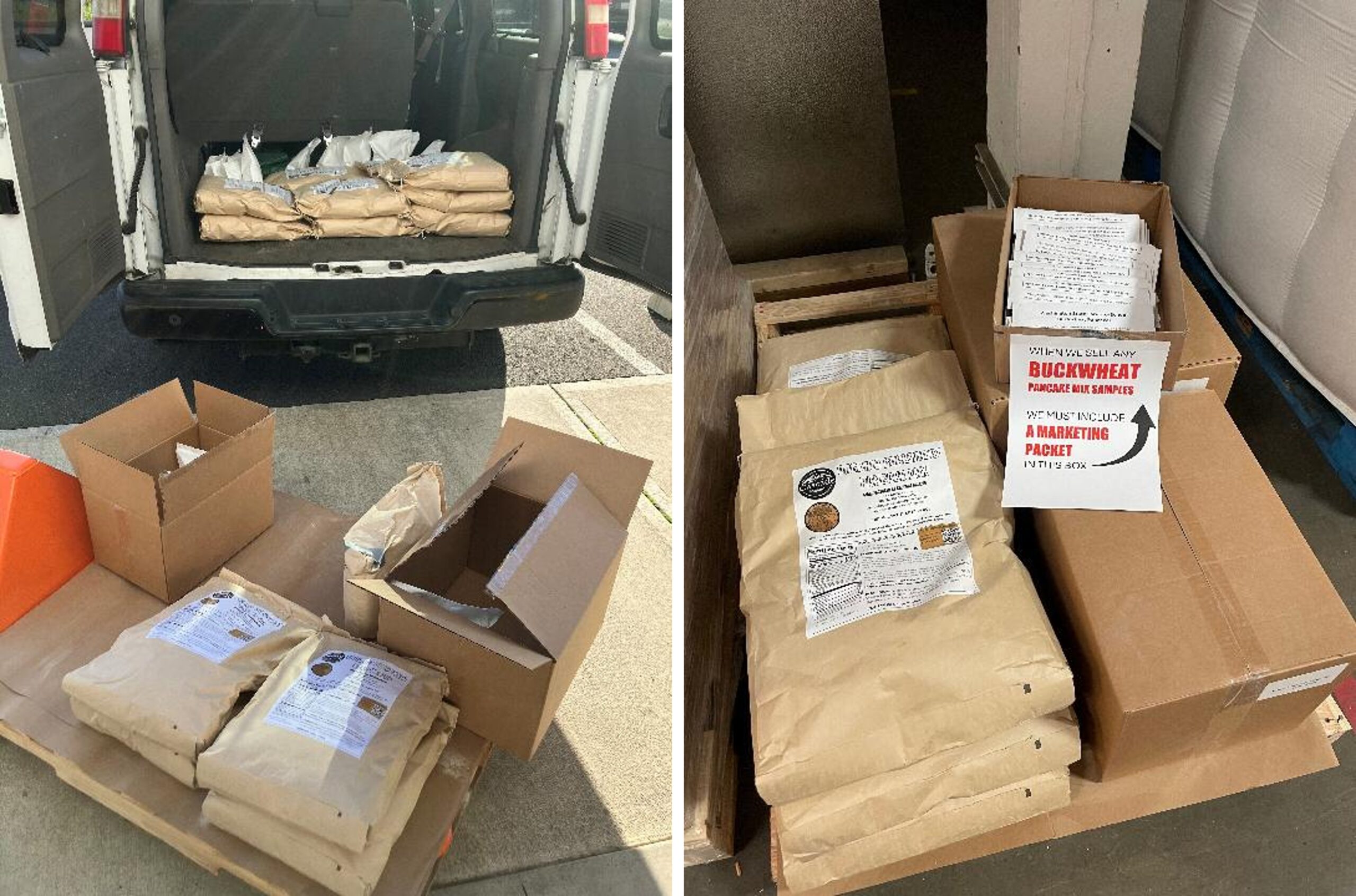
An information and evaluation packet for school districts testing the mix was developed. This consisted of the nutrition label, the whole-grain equivalent, an instructional video on how to prepare the pancake mix as flapjacks and as bars (https://www.youtube.com/watch?v=dGggZUom7ug), a simple evaluation ballot, and the overall product label for reference. The same information was provided online, and a QR code both to overall project information and to the evaluation form was included as well.

In the fall and winter of 2024/25, youth at approximately 18 school districts around the state received the opportunity to taste buckwheat pancakes and buckwheat pancake breakfast bars as a result of this project. Participating School Districts include Concrete, Lopez Island, Blaine, Granite Falls, Ferndale, Burlington-Edison, La Conner, Kahlotus, Onion Creek, Almira, Catholic Charities, Gonzaga Family Haven, Inchelium, Washtucna Farm to School, Ellensburg, Curlew Farm to School, Olympia, Aberdeen, Pe Ell, Hoquiam, Pioneer, and Griffin.
Evaluations of these schools’ experiences with the pancake mix are underway. Four districts had reported at time of the project final report to the Western SARE project in June 2025. Funding to follow-up with school districts was awarded in late 2024 through the Organic Research and Extension Initiative. By the end of the of the first funding cycle through Western SARE, Cascade Milling was interested in exploring commercialization through the WSU Office of Commercialization, a process which is being explored as part of the OREI project.
Millet Variety Trials and On-farm Evaluations
- Mother Trial
- A proso millet “mother trial” was planted at Spillman Agronomy Farm in Pullman on May 22, 2022. Seven varieties (Earlybird, Dawn, Horizon, Huntsman, Plateau, Sunrise, and Sunup) were planted in a replicated complete block design.
- In-season data collection included rate of emergence, days to heading, days to maturity, plant height, and emergence.
- Plots were harvested between September 1 and September 15, 2022.
- Seed samples from each plot were cleaned and dehulled to prepare for analysis of seed morphology and nutrition (in progress).
- On-farm Trials
- Five growers across the inland Pacific Northwest planted proso millet “baby trials” in 2022. Each grower was assigned between three and seven varieties to plant in unreplicated strips on their farms using full-scale planting equipment. Growers planted and managed their crops, but researchers collected samples from each plot to compare plant height and yield of test varieties.
- Interviews were conducted with each grower before planting and after harvest in order to understand grower management decisions and overall experience working with the crop.
Table 14. Averages by Variety
|
Variety |
Total reps across sites (n= ) |
Mean Yield (g/m2) |
Mean Height (cm) |
|
Dawn |
3 |
195 |
70 |
|
Sunrise |
4 |
181 |
85 |
|
Earlybird |
2 |
176 |
94 |
|
Horizon |
3 |
142 |
75 |
|
Sunup |
2 |
122 |
84 |
|
Sunrise |
4 |
181 |
85 |
Table 15. Averages by Grower
|
|
Number of Varieties Planted (n= ) |
Mean Yield (g/m2) |
Mean Height (cm) |
|
Grower 1 |
7 |
158 |
94 |
|
Grower 2 |
5 |
114 |
61 |
|
Grower 3 |
3 |
114 |
73 |
|
Grower 4 |
4 |
198 |
97 |
|
Grower 5 |
4 |
NA |
84 |
|
Grower 1 |
Grower 2 |
Grower 3 |
Grower 4 |
Grower 5 |
|
|
Location |
Edwall, WA |
Chelan, WA |
Genesee, ID |
Genesee, ID |
Genesee, ID |
|
Farm Acreage |
1500 acres |
16000 acres |
2200 acres |
2800 acres |
4900 acres |
|
Certifications |
NA |
Farm smart |
Food Alliance, Farm Smart |
Food Alliance, Shephard’s Grain |
Food alliance, Farm Smart |
|
Management Style |
No till, some conservation farming |
No till, diverse crop rotation |
No till, cover crop, diverse cropping rotation |
No till and minimum till |
No till, cover crop, integrated livestock, some biological |
|
Grower 1 |
Grower 2 |
Grower 3 |
Grower 4 |
Grower 5 |
|
|
Planting Date |
6/12/22 |
6/1/2022 |
6/20/2022 |
5/26/2022 |
5/24/2022 |
|
Harvest Date |
10/4/22 |
10/15/22 |
9/27/2022 |
9/28/2022 |
9/13/2022 |
|
Residue Management |
No till |
No till |
No till |
till with fert close to seeding (9 in shank, 3-4 in deep) |
No till |
|
Fertilizer |
|||||
|
Product |
2 gal UAN, 2 gal orthophos + molasses |
100 lb N, 15 lb P, 20 lb S Gypsum, humic, sugar; manganese, magnesium and seed water |
100 lb N, 15 lb P, 20 lb S |
NA |
50 lbs N, 15 lbs S, 20 lbs P |
|
Placement |
Paired row 3”, banded in middle 1” below |
Ran through drill; came over the top |
Through drill kit |
||
|
Timing |
at planting |
at planting |
at planting |
At planting |
|
|
Preplant Herbicide |
|||||
|
Product |
Round up |
Round up |
Clarity |
||
|
Rate |
24 oz; a couple days before planting |
1 application; month before planting |
4 oz |
||
|
In-season herbicide |
NA |
NA |
NA*** |
||
|
Product |
2,4-D Amine |
||||
|
Rate |
|||||
|
Seeding Rate |
25 lbs/acre* |
15 lbs/acre |
30 lbs/acre |
11 lbs/acre |
35 lbs/acre |
|
Row Spacing |
9.5” paired rows |
9” paired row |
4.5” paired rows |
7.5” |
12” |
|
Seeding Depth |
.5-.75” |
1.5" |
1” (varies in rocky ground) |
.75-1.25 in |
.75 in |
|
Harvest Method |
Swath/pickup |
Direct |
Chemical dry down, direct |
Direct |
Direct |
Food Science
- Six proso millet were planted in the same controlled location, and several varieties were planted on various farms across the PNW. We analyzed 28 samples for their functional properties and proximate composition.
- Six buckwheat varieties were planted in the same controlled location, and several varieties were planted in two farms across the PNW. We analyzed 14 samples for their functional properties and proximate composition.
- Performed a study on the influence of the proximate and physicochemical properties of dehulled and whole buckwheat flour on focaccia bread quality.
Table 16: Name, growing location, and proximate composition of 7 proso-millet flours
|
Code |
Variety |
Growing location |
Protein g/100g |
Starch Protein g/100g |
Fat Protein g/100g |
Moisture Protein g/100g |
Ash Protein g/100g |
|
22PM1 |
Plateau |
Mother location |
13.19±0.18 |
62.63±3.61 |
4.54±0.24 |
8.72±0.37 |
0.89±0.06 |
|
22PM2 |
Plateau |
Bishop farm |
10.94±018 |
71.10±2.95 |
4.87±0.17 |
7.70±0.05 |
1.04±0.07 |
|
22PM3 |
Plateau |
Poole farm |
11.19±0.0 |
65.27±3.67 |
3.76±0.27 |
8.97±0.49 |
1.01±0.06 |
|
22PM4 |
Plateau |
Herman farm |
12.88±0.18 |
68.10±2.46 |
4.16±0.04 |
8.74±0.20 |
0.98±0.04 |
|
22PM5 |
Plateau |
Zenner farm |
13.13±0.35 |
66.77±1.59 |
4.57±0.11 |
8.97±0.09 |
0.88±0.06 |
|
22PM6 |
Early bird |
Mother location |
12.47±0.04 |
63.87±1.91 |
4.31±0.54 |
8.00±0.28 |
0.90±0.04 |
|
22PM7 |
Early bird |
Bishop farm |
9.88±0.00 |
72.83±2.97 |
3.90±0.03 |
7.47±0.08 |
1.10±0.28 |
|
22PM8 |
Early bird |
Herman farm |
12.56±0.80 |
64.80±3.89 |
3.62±0.18 |
8.15±0.07 |
1.04±0.21 |
|
22PM9 |
Horizon |
Mother location |
12.19±0.18 |
70.00±1.91 |
3.31±0.06 |
9.29±0.08 |
0.94±0.10 |
|
22PM10 |
Horizon |
Bishop farm |
7.59±0.04 |
74.07±0.29 |
2.40±0.16 |
7.69±0.22 |
0.93±0.02 |
|
22PM11 |
Horizon |
Odberg farm |
9.91±0.13 |
64.47±4.24 |
3.31±0.05 |
9.10±0.13 |
1.14±0.14 |
|
22PM12 |
Horizon |
Poole farm |
9.91±0.13 |
67.27±1.10 |
2.89±0.70 |
7.52±0.29 |
1.25±0.13 |
|
22PM13 |
Sunrise |
Mother location |
12.75±0.0 |
73.13±4.67 |
3.73±0.23 |
9.41±0.02 |
0.90±0.06 |
|
22PM14 |
Sunrise |
Bishop farm |
8.69±0.09 |
73.90±0.44 |
3.87±0.14 |
8.09±0.15 |
1.02±0.06 |
|
22PM15 |
sunrise |
Odberg farm |
9.72±0.04 |
69.69±2.4 |
3.61±0.09 |
6.86±0.11 |
1.22±0.00 |
|
22PM16 |
Sunrise |
Herman farm |
12.41±0.04 |
65.57±2.11 |
3.63±0.47 |
7.44±0.04 |
1.10±0.12 |
|
22PM17 |
Sunrise |
Zenner farm |
12.63±0.00 |
72.80±1.9 |
2.98±0.80 |
7.70±0.47 |
0.75±0.14 |
|
22PM18 |
Huntsman |
Mother location |
12.94±0.09 |
70.17±1.07 |
3.90±0.19 |
8.10±0.20 |
0.93±0.11 |
|
22PM19 |
Huntsman |
Bishop farm |
9.97±0.13 |
69.10±1.82 |
3.64±0.27 |
6.74±0.09 |
1.06±0.03 |
|
22PM20 |
Huntsman |
Odberg farm |
9.88±0.00 |
65.13±1.53 |
3.64±0.04 |
6.82±0.12 |
1.34±0.07 |
|
22PM22 |
Huntsman |
Herman farm
|
12.38±0.18 |
59.57±3.84 |
4.47±0.21 |
6.84±0.09 |
1.31±0.17 |
|
22PM24 |
sunup |
Mother location |
11.81±0.00 |
63.67±1.86 |
3.47±0.14 |
7.29±0.04 |
0.89±0.15 |
|
22PM25 |
Sunup |
Bishop |
7.91±0.13 |
68.90±3.70 |
2.51±0.40 |
6.69±0.06 |
1.03±0.07 |
|
22PM26 |
Sunup |
Poole |
9.88±0.09 |
72.50±1.61 |
2.83±0.09 |
7.87±0.14 |
1.08±0.14 |
|
22PM27 |
Dawn |
Mother location |
12.69±0.44 |
71.17±1.07 |
1.63±0.30 |
7.45±0.05 |
1.22±0.18 |
|
22PM28 |
Dawn |
Bishop farm |
9.75±0.18 |
64.13±2.90 |
2.91±0.17 |
6.50±0.06 |
1.14±0.17 |
|
22PM29 |
Dawn |
Poole farm |
9.75±0.18 |
61.53±2.93 |
3.30±0.25 |
6.83±0.06 |
1.33±0.11 |
|
22PM30 |
Dawn |
Zenner farm |
12.41±0.22 |
66.43±2.40 |
1.14±0.08 |
6.78±0.06 |
1.22±0.13 |
Table 17: Functional properties of 7 proso-millet varieties grown in different locations.
|
Code |
WHC (g/g) |
OHC (g/g) |
WAI (%) |
WSI (%) |
FSP (%) |
|
22PM1 |
1.12±0.03 |
0.85±0.07 |
1.81±0.01 |
5.87±0.27 |
1.93±0.00 |
|
22PM2 |
1.15±0.00 |
0.84±0.04 |
1.83±0.00 |
6.41±0.06 |
1.96±0.01 |
|
22PM3 |
1.14±0.01 |
0.91±0.04 |
1.83±0.02 |
7.17±0.10 |
1.97±0.02 |
|
22PM4 |
1.11±0.01 |
0.89±0.03 |
1.83±0.01 |
6.62±0.02 |
1.96±0.01 |
|
22PM5 |
1.12±0.01 |
0.85±0.01 |
1.86±0.00 |
6.70±0.05 |
1.99±0.00 |
|
22PM6 |
1.03±0.11 |
0.86±0.10 |
1.97±0.15 |
3.19±0.07 |
2.03±0.16 |
|
22PM7 |
1.08±0.01 |
0.90±0.02 |
1.83±0.00 |
3.72±0.25 |
1.87±0.04 |
|
22PM8 |
1.10±0.01 |
0.94±0.05 |
1.90±0.02 |
2.77±0.09 |
1.96±0.02 |
|
22PM9 |
0.98±0.03 |
0.84±0.11 |
1.87±0.02 |
2.79±0.02 |
1.92±0.02 |
|
22PM10 |
1.10±0.02 |
0.82±0.02 |
1.85±0.02 |
3.28±0.07 |
1.94±0.06 |
|
22PM11 |
1.08±0.03 |
0.85±0.04 |
1.83±0.01 |
4.03±0.05 |
1.91±0.01 |
|
22PM12 |
1.12±0.01 |
0.95±0.04 |
1.87±0.01 |
3.47±0.22 |
1.93±0.01 |
|
22PM13 |
1.05±0.01 |
0.93±0.03 |
1.90±0.04 |
3.00±0.04 |
1.96±0.05 |
|
22PM14 |
1.07±0.01 |
0.94±0.04 |
1.86±0.03 |
3.24±0.07 |
1.92±0.03 |
|
22PM15 |
1.13±0.02 |
0.90±0.04 |
1.86±0.03 |
4.33±0.06 |
1.94±0.03 |
|
22PM16 |
1.11±0.00 |
0.90±0.04 |
1.89±0.04 |
3.05±0.23 |
1.95±0.05 |
|
22PM17 |
1.05±0.10 |
0.94±0.02 |
1.87±0.00 |
2.96±0.07 |
1.93±0.00 |
|
22PM18 |
1.11±0.03 |
0.93±0.05 |
1.91±0.05 |
3.09±0.14 |
1.98±0.05 |
|
22PM19 |
1.08±0.02 |
0.88±0.04 |
1.86±0.00 |
3.63±0.09 |
1.93±0.01 |
|
22PM20 |
1.09±0.03 |
0.95±0.03 |
1.84±0.03 |
4.60±0.24 |
1.93±0.04 |
|
22PM22 |
1.15±0.03 |
0.98±0.01 |
1.87±0.01 |
3.22±0.06 |
1.93±0.01 |
|
22PM24 |
1.16±0.01 |
1.01±0.01 |
1.89±0.02 |
2.95±0.05 |
1.94±0.02 |
|
22PM25 |
1.09±0.05 |
0.98±0.01 |
1.84±0.01 |
2.69±0.09 |
1.89±0.01 |
|
22PM26 |
1.07±0.06 |
1.00±0.04 |
1.88±0.03 |
2.79±0.06 |
1.94±0.04 |
|
22PM27 |
0.44±1.15 |
1.02±0.07 |
1.89±0.03 |
2.71±0.05 |
1.94±0.03 |
|
22PM28 |
1.17±0.05 |
0.84±0.02 |
1.85±0.02 |
2.80±0.04 |
1.91±0.02 |
|
22PM29 |
1.17±0.02 |
0.88±0.07 |
1.90±0.00 |
2.77±0.13 |
1.96±0.00 |
|
22PM30 |
1.18±0.01 |
0.88±0.02 |
1.86±0.19 |
2.77±0.09 |
1.91±0.19 |
Note: abbreviations: WHC-water holding capacity, OHC-oil holding capacity, WAI-water absorption index, WSI-water solubility index, FSP-flour swelling power.
Table 18: Name, growing locations, protein content, and functional properties of 6 buckwheat varieties grown in different locations.
|
Code |
Variety |
Growing location |
Protein g/100g |
WHC (g/g) |
OHC (g/g) |
EA (%) |
ES (%) |
|
22BK1 |
WSU |
Mother location |
9.72±0.08 |
1.55±0.01 |
1.04±0.08 |
53.26±4.71 |
95.00±3.00 |
|
22BK2 |
Kitawase |
Mother location |
10.40±0.14 |
1.62±0.04 |
1.11±0.02 |
53.82±3.26 |
95.28±0.96 |
|
22BK3 |
Garnett |
Mother location |
9.89±0.10 |
1.58±0.01 |
1.11±0.03 |
50.17±1.87 |
95.00±0.83 |
|
22BK4 |
Horizon |
Mother location |
9.76±0.35 |
1.58±0.03 |
1.09±0.03 |
49.77±3.15 |
94.72±2.09 |
|
22BK5 |
Koto |
Mother location |
9.53±0.06 |
1.58±0.03 |
1.02±0.04 |
51.49±3.82 |
95.00±1.67 |
|
22BK51 |
Mancan |
Mother location |
10.10±0.15 |
1.60±0.01 |
1.07±0.01 |
52.42±1.64 |
90.81±2.50 |
|
22BK6 |
Kitawase |
Heldin farm |
11.50±0.14 |
1.74±0.02 |
1.04±0.08 |
53.45±2.52 |
90.25±0.94 |
|
22BK7 |
Mancan |
Heldin farm |
12.10±0.00 |
1.70±0.06 |
1.09±0.04 |
50.61±3.44 |
88.89±9.48 |
|
22BK8 |
Mancan |
Finriver farm |
11.05±0.21 |
1.67±0.05 |
1.09±0.02 |
54.60±3.67 |
83.33±1.66 |
|
22BK9 |
Koma |
Heldin farm |
10.90±0.00 |
1.69±0.02 |
1.05±0.03 |
53.40±1.9 |
91.39±1.73 |
|
22BK10 |
Horizon |
Finriver farm |
11.05±0.07 |
1.67±0.01 |
1.11±0.04 |
52.40±2.62 |
90.83±0.83 |
|
22BK11 |
Koto |
Finriver farm |
10.80±0.28 |
1.67±0.03 |
1.09±0.02 |
53.95±1.18 |
86.39±1.27 |
|
22BK12 |
Koma |
Finnriver farm |
11.10±0.14 |
1.69±0.00 |
1.10±0.05 |
57.13±2.4 |
87.43±0.84 |
|
22BK13 |
WSU |
Heldin farm |
10.65±0.07 |
1.63±0.02 |
1.11±0.02 |
52.78±3.15 |
89.38±2.58 |
Note: abbreviations: WHC-water holding capacity, OHC-oil holding capacity, EA-emulsion ability, ES-emulsion stability.
Furthering our end-use quality results for Objective 3, we designed an experiment to develop a basic understanding the influence of varietals and growing year on agronomic yield parameters and the physicochemical properties of common buckwheat.
The effects of five commercially available buckwheat (Fagopyrum esculentum Moench) varieties ('Horizon, 'Kitawase', 'Koto', 'Mancan' and 'Tinker') and two growing years on agronomic yield parameters and physicochemical properties were investigated to assess their suitability for practical integration into food systems in the Pacific Northwest (PNW) region. Most variables displayed a significant year x variety interaction except for canopy height (variety, year), fat (year), ash (year), emulsion ability (year), water solubility index (year), pasting temperature (variety), and emulsion stability (not significant). Variations between varieties within a given year were observed for canopy height, in 2022 for all the proximate properties and in 2023 for insoluble dietary fiber and moisture content, for the year 2023 in water and oil holding capacities in 2023, and for all the pasting properties except for pasting temperature and breakdown in 2022. Tinker displayed the most stable behavior when comparing the agronomy and physicochemical properties of the buckwheat flours between the two years, while Kitawase was the least stable variety, followed by Koto. Further research with controlled irrigation and fertility crop management treatments across several growing seasons would help further refine buckwheat varietal response to variations in growing behavior and physicochemical properties observed across two different growing seasons in our trials. These efforts could help predict end-user applications for specific buckwheat varieties, which is essential for their successful integration into the food system.
We followed up this research by studing the physicochemical properties of buckwheat flours and their influence on focaccia bread quality. Focaccia bread was prepared with 25%, 50%, and 75% substitution rates of whole (WBK) and dehulled buckwheat flour (DBK) with refined wheat bread flour.
The flours showed differences in protein content; the WBK was high in fiber while the DBK was composed mainly of starch. The peak time in the mixograph increased, and the height at peak time decreased as the buckwheat substitution rate increased. Gluten dilution partially explains these results. The specific volume of the focaccia decreased with 50% and 75% substitution rate of WBF, possibly attributable to fiber particles limiting the expansion of gas cells in the bread. The number of such cells, measured by the C-cell, increased, and cell diameters decreased as the buckwheat substitution levels increased. These trends were also evident in the decrease in bread density. Focaccia, with 25% WBK and 25% and 50% DBK, had acceptable quality attributes comparable to those of the control.
Research Conclusions
Farmers
Farmers are considerably interested in growing buckwheat and conveyed that certain agronomic challenges must be overcome such as refining seeding rates, seeding date, site selection, irrigation, and fertility practices. Harvesting was considered difficult as many farmers do not have pick-up headers for combines, and the crop can mature and dry down evenly or insufficiently prior to harvest. Buckwheat production is limited by lack of markets.
School Food Service Buyers
School food service buyers are very interested in buckwheat products and willing to experiment with them. Meeting whole grain standards, conducting taste tests to introduce novel foods to kids, adequate nutritional statements, and ease of preparation were identified as key conditions to adoption. Loss of the WSDA Farm-to-School program deals a headlong blow to the prospects of introducing more Washington-grown foods into school meals, including any more expensive breakfast products. Continued funding for the effort through OREI will allow the project team to continue to explore how the mix can become a staple in school breakfasts throughout the state.
Youth Eaters
Approximately two-thirds of youth taste-testers approved of buckwheat-based products, which is considerable provided how greatly pancakes/bars differ visually and in terms of flavor from standard prepared frozen pancakes. Youth were extremely interested in experimenting with growing buckwheat, milling buckwheat groats, and making and tasting their own pancakes. Literature demonstrates that multiple novel and socially-engaging interventions greatly increase acceptance of new foods by young eaters; the experience of our research and SNAP-Ed outreach teams very strongly aligned with those conclusions.
Milling Partners
Washington mills and manufacturers are interested in new products and willing to collaborate, particularly when branding and marketing collaborations bring positive notoriety to their businesses. Collaboration with enthusiastic private partners is critical to value-chain development for new Washington products. Nuance and continued flexibility is essential to nurturing these partnerships, always looking for ways to incentive private participation in a way that can lead to genuine economic benefit.
The Importance of Value Chain Partners
Value-chain development in this project was dependent upon a private mill (Cascade Milling) already having a similar pancake mix that could be adapted to include buckwheat, availability of distribution partners such as Food Hubs to help connect products to school buyers, partnership with educators such as SNAP-Ed programs and Educational Service Districts to help introduce products to students and school food service employees, and help from OSPI and Washington School Nutrition Association organizations willingly spreading the word about the mix.
Objective 1 (Baseline) research is not complete. Samples require further nutritional and functionality testing and several additional producers have committed to providing baseline samples. Interviews are ongoing. Objective 2 (Field Trials) research has not yet begun. Objective 3 (Variety Characterization/Product Formulation) research is underway for product formulations, but not complete.
Research Outcomes
Summary for Production Buckwheat in the PNW
There are two main threats to dryland buckwheat yield in the later growing season in the western PNW, 1) too little soil water threatening to stymie seed fill, and 2) wet fall weather conditions that preclude harvests. The first example we observed through how austere late season conditions apparently impacted yields of the later-maturing varieties. Earlier-maturing varieties conversely appeared to have a degree of resilience from the limiting late season conditions in 2022. Yield potential aside though, dry conditions in the late 2022 season were conversely a boon for direct combine harvest. The 2023 season was different. Yield potential appeared to be substantially bolstered by late season water availability, but this conversely, in-turn, precluded efficient combine harvest. Because buckwheat has indeterminate growth and is highly responsive to water availability, late season rains precipitated a resurgence of leafy growth and flowering just as the buckwheat was nearly at a stage where it was senescent enough to direct harvest. Early, significant fall rains further precluded an efficient combine harvest, and diminishing hours of daylight and temperature in fall put a dry harvest further out of reach. This latter situation in 2023 highlighted the importance of having swathing capacity as a long-term investment towards growing buckwheat successfully in the region. Swathing allows for harvest to occur earlier in the season when the threat of rain during harvest is less likely. Furthermore, for harvesting earlier in the season, earlier maturing varieties were illustrated to be important to realizing yield potential. Otherwise, with direct harvest of buckwheat in this region it was also highlighted in these trials how critical is to have robust seed drying capacity. This is due to the amount of green matter that inevitably ends up in the combine hopper because it is too heavy to be winnowed out of the combine. The 2023 direct combine harvest needed considerable heated drying and post-harvest cleaning, without which it would have undoubtedly spoiled.
A last note on successfully combine harvest of buckwheat yield potential relates to buckwheat stature. Buckwheat produces seed on the lower and upper portions of the plant, and is a relatively short crop to be harvested with a combine. This means that it is easier to harvest the full plant of varieties that have a taller stature. For instance, although the short-statured WSU variety exhibited some uniquely favorable traits, growers would need to consider also that a variety like this will demand more combine operation skill and the potential for yield losses if lower portions of the plant are not able to be harvested due to limitations on how low the combine can harvest. Taller statured varieties also have a benefit in swathing, where the crop stubble can be left taller for better airflow under the buckwheat windrows.
Additional Research Outcomes for Buckwheat Production
- Buckwheat can be grown with or without irrigation in Western Washington, but growers need to take into account seeding date, weather/seasonal water availability (in soil and projected from precipitation), soil type, and availability of irrigation water to manage for a successful buckwheat crop. Some additional information on interactions between these factors, with quantified cut-off thresholds, would be helpful.
- Integrating legumes into buckwheat production can be used to boost weed suppression, increase nitrogen fixation, provide additional nectary resources, and improve soil cover. Farmers in this trial experimented with Birdsfoot trefoil and fava beans.
- Utilizing low ground (subirrigated), proper planting date, or irrigation, is essential to plant stand and thereby weed suppression by buckwheat
- Growers should consider increasing seeding rate from 55 lbs/ac to as much as 100 lbs/ac for sites with high weed pressure, or other factor that may inhibit canopy closure.
- Selecting a variety other than Mancan will increase canopy closure and increase effectiveness of buckwheat as a weed-suppressing crop
- Growers need to ensure adequate moisture either through sub-irrigation, earlier seeding date, or irrigation to ensure crop vigor and potential both for weed suppression and high yield
Education and Outreach
Participation Summary:
Year 1.
At the outset of the project, a project newsletter was sent to producers who agreed to host on-farm variety trials of buckwheat or proso millet (n = 21). The newsletter included links to relevant reference materials, a schedule of important upcoming activities, a summary of successful project benchmarks, and a team directory with contact information and roles of each researcher. Periodic newsletters, and numerous phone calls and emails, maintained communication with the group of producer-collaborators. The newsletters complemented direct communications with producer collaborators during the project, but it is unknown how much they were read.
Emails and newsletters included information for on-farm trial management (e.g., field preparation, planting, chemical inputs, and harvest practices). Guidance was informed by Extension documents from other universities. The team clearly disclosed that the information provided to producers was summarized from research not specific to our region; producers were instructed to use best judgement in tailoring practices to their local conditions. Producer experiences during the upcoming field trial seasons will inform two management guides (one for proso millet and one for buckwheat) that will be published as part of this project.
A webpage for the project was developed and added to the Sustainable Seed Systems Lab website (https://www.sustainableseedsystems.org/new-grains-nw.html). The webpage uses a new name for the project, New Grains Northwest, which was developed during several project branding sessions. The webpage provided an overview of the project, project photos, project rationale, project team and stakeholder information, baseline data, and field trial information. Interested stakeholders were frequently directed to the webpage.
Our first research station field day for the proso millet mother trial and a buckwheat test plot occurred July 7, 2022, at the Spillman Research Farm in Pullman, WA as part of the Inland Northwest Artisan Grains Conference.
Year 2.
Buckwheat Outreach and Supply Chain Development
Supply chain development was supported through a) collaboration with Washington State school meals programs and b) industry/culinary partners.
(a) Regarding school meal partners, the WSU/OSPI survey, and WSNA evaluations demonstrate interest in utilizing products made from Washington-grown millet and buckwheat. Key barriers to supply chain development are confirmed markets, which could be the schools themselves, and a private partner capable of and interested in development products that utilize millet and buckwheat.
The school survey provided preliminary data regarding school interest in millet and buckwheat products, which it was thought could provide a sufficient market to develop a product line of dry bread mixes (focaccia and pancakes) and a breakfast bar. To address private partner for product line development, the outreach team has explored Clif Bar, Patagonia Inc., and Cascade Milling. Neither Clif nor Patagonia have expressed interest beyond initial involvement as stakeholders in the project.
Year 3.
Cascade Mill out of Royal City, WA is a company that mills organic grains for a variety of wholesale markets through Washington State and the Pacific Northwest. Preliminary discussions with Cascade Mill suggest interest, as the company is already mixing a line of pancake mix that they intend to market to school meal programs. Added nutritional value, and additional farm and University partnership, were compelling for the company and meetings occurred between July and August 2023. A partnership included shipping Washington grown buckwheat to Cascade Milling in fall of Year 3 for pilot mix development. To make economic sense, Cascade Mill representative Patrick Boss noted that “…the volume would need to be at least about 1 full truckload (about 42,000 lbs. of product) once every two months or once a quarter.” To determine if this demand exits, the research team will follow up with school meal partners who participated in the pilot (18 schools) using follow-up funding through a USDA OREI grant.
Opportunity to utilize farm-to-school grant funding was identified in spring 2023 through meetings with WSDA Farm-to-School program coordinator Annette Slonim, and OSPI Farm-to-School coordinator Nichole Garden. Programs that could help support purchase of Washington-grown grains for school meal programs include the following:
- WSDA Farm-to-School Purchasing Grant program (https://agr.wa.gov/departments/business-and-marketing-support/farm-to-school-toolkit/grants), the current round of which opened August 2023 and closes September 25th, 2023
- The OSPI Commodity Food Purchasing grant program, that subsidizes procurement of W-code foods to offset use of potentially more expensive WA-sourced ingredients in processed foods (such as pasta sauce, or products envisioned by this program: focaccia bread, pancake mix, or breakfast bar)
- OSPI Local Food for Washington Schools program, which provides funding for sourcing specific products for school meal programs such as bison, salmon, frozen processed vegetables, or potentially one of the products developed for this program)
(b) Regarding industry connections for millet and buckwheat supply chain development, several local partners and small and larger scales were interested in utilizing millet and buckwheat in specialty manufacturing and for value-added farm sales. These included:
- Farms such as Kirsop Farm that have an interest in direct sales of buckwheat groats at farmers markets
- Hedlin Farm which is interested in culinary varieties that could sell for a higher price premium
- Ghostfish Brewing company which could utilize Washington-grown grain for malting
- Malting companies such as Linc Malt, which has opportunity to market Washington-grown malted buckwheat
- Snacktivist, a specialty foods manufacturer who is interested in Washington-grown millet and buckwheat varieties if they were available as groats or flour
- Restaurant partners including Elise Landry at Chicory Restaurant in Olympia, WA, and Katchka Restaurant chef Bonnie Morales, who utilized buckwheat on her menu until the Ukraine-Russia conflict, and she could no longer source the grain reliably
- Soba noodle makers in Portland, OR and elsewhere who need a stable supply of buckwheat flour if it could be sourced from Washington farms
- Milling and baking companies such as small-scale breadmaker and miller Ryan at Baker-Potter, who would like to source buckwheat groats from Washington for milling but has no supply; and Cairnspring Mill owner Kevin Morse
Buckwheat and Millet Education and Outreach
Educational Community Events
Buckwheat and millet education and outreach tables were included in the 2022 Sagre del Radicchio (https://www.chicoryweek.com/events/2022/8/30/radsagra). Photos of the event are available on the project website (https://www.sustainableseedsystems.org/new-grains-nw.html).
Three education and outreach events occurred in 2023, including the WSNA pre-conference tour held July 2023 for members of the Washington School Nutrition Association, a “Buckwheat Fest” on August 28th in Chimacum, WA (https://seedalliance.org/events/buckwheat-festival/), and a WSU Extension/Culinary Breeding Network “Field to Flavor Showcase” in Vancouver, WA.
At the Chimacum Buckwheat Festival, held in 2023 and 2024 (after the WSARE funding had ended), Attendees increased to greatly increased knowledge of:
- Benefits of growing buckwheat for grain: 90%
- Goals for breeding improvement: 100%
- How the grain is processed and used: 100%
- Culinary uses of buckwheat: 80%
- Opportunities and challenges for marketing buckwheat: 100%
- Where you might fit in to community partnerships to the buckwheat farm to market adventure: 80%
- Attendee intention to use this knowledge: 87%
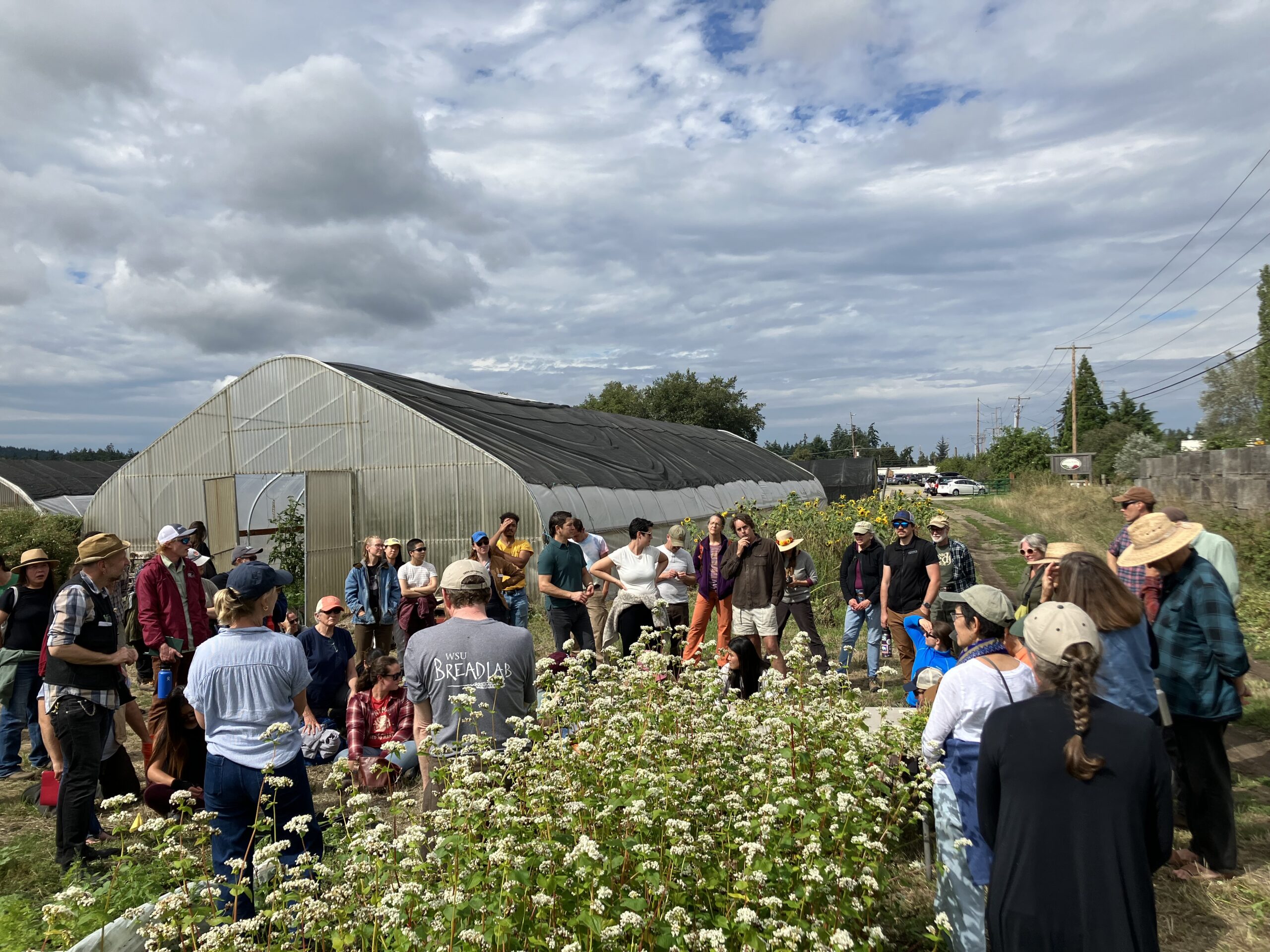
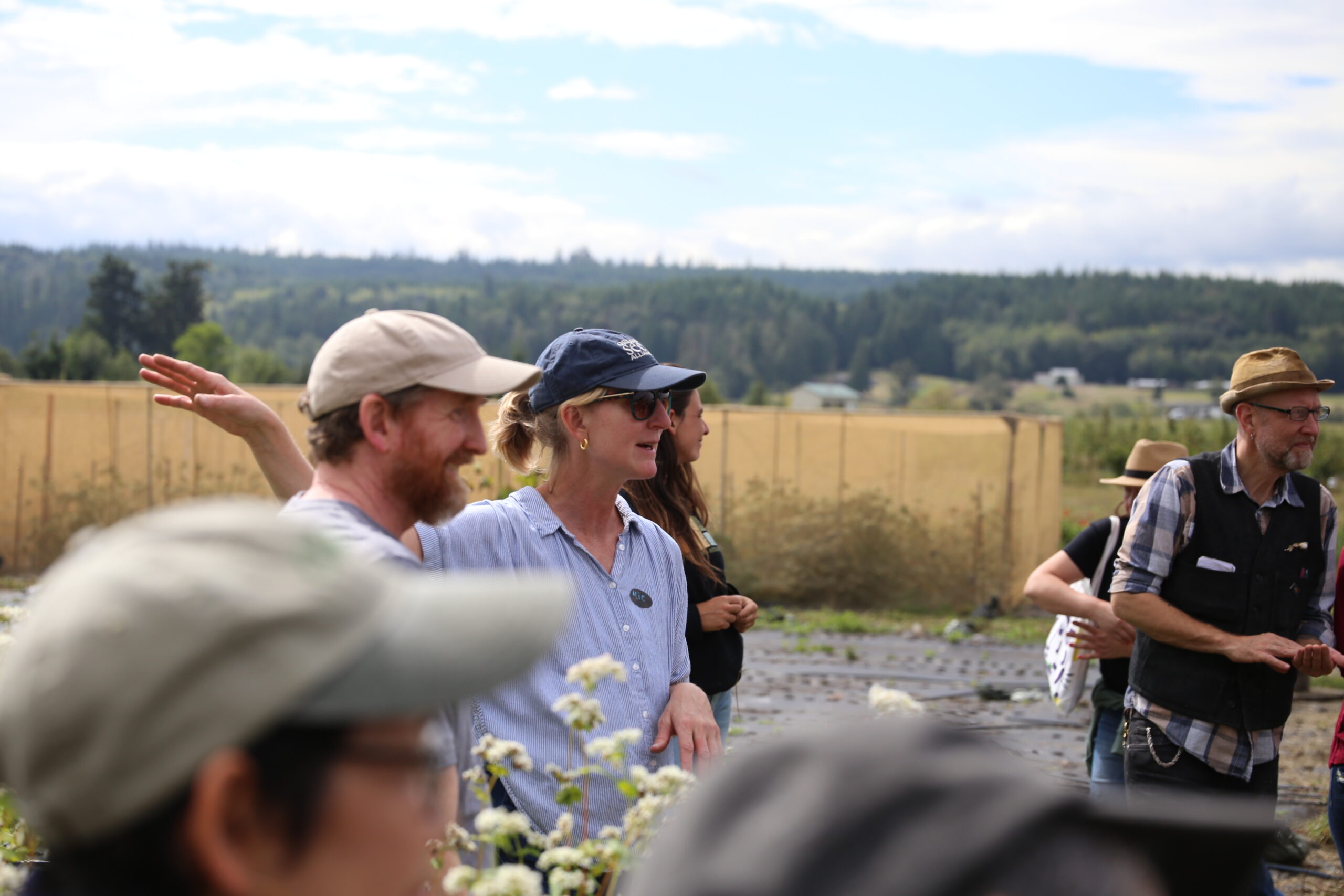
At the WSNA pre-conference tour
In summer 2023 a “Field to Flavor Showcase” event was organized as a pre-conference tour for members of the Washington School Nutrition Association. Members were taken on farm tours, a tour of buckwheat research plots, and served novel dishes featuring buckwheat. Recipe formulations from the WSU Food Science program for pancakes and focaccia bread were utilized. Evaluation feedback provided direct data from 27 WSNA members, who are employed as lead chefs and food service directors at Washington State K-12 schools (evaluation results noted below in Outcomes).
Among the 27 attendees, 90% (n=22 respondents) increased knowledge of culinary uses of millet and buckwheat, 86% increased knowledge of opportunities for including millet or buckwheat products in school meal programs, 86% learned how crop rotations (such as those that include millet and buckwheat) improve the sustainability of agriculture, and 83 percent increased knowledge of crop seasonality to support purchasing directly from farms. Among those, an average of 79% plan to utilize their knowledge, with some respondents noting their limited capacity to implement change as they are not food service directors but rather line cooks or head chefs.
School District Involvement
Taste Testing at Eighteen School Districts Around Washington State
Youth at approximately 18 school districts around the state received the opportunity to taste buckwheat pancakes and buckwheat pancake breakfast bars as a result of this project. Ellensburg School District posted pictures of their experience on Facebook: https://wpcdn.web.wsu.edu/wp-extension/uploads/sites/2056/2025/02/Ellensburg-SD-Facebook-Post.png. Participating School Districts include Concrete, Lopez Island, Blaine, Granite Falls, Ferndale, Burlington-Edison, La Conner, Kahlotus, Onion Creek, Almira, Catholic Charities, Gonzaga Family Haven, Inchelium, Washtucna Farm to School, Ellensburg, Curlew Farm to School, Olympia, Aberdeen, Pe Ell, Hoquiam, Pioneer, and Griffin. Evaluations of these schools are underway (4 reporting at time of final SARE report, with funding through a follow-on grant through OREI to follow up with the remaining schools).

Education and Outreach Outcomes
Recommendations Derived from Education and Outreach Activities
- Community events are highly effective at generating interest, especially those that integrate culinary, cultural, research, and sensory elements. Including chefs and students, especially youth, was very effective at reaching and inspiring new audiences
- Taste testing with elementary school youth is a very effective way to expand their sense of culinary options. Students were daring, interested, honest, funny, and excited. They loved seeing buckwheat from garden to grain to flour to pancake, and finally tasting them
- The SNAP-Ed program is an amazingly effective partner to connect with schools. Hopefully future funding will be provided to continue these inspiring partnerships between agriculture, food science, and SNAP-Ed in the classroom.
- County Fairs are untapped events for integrating more local food educational activities. A static booth is likely to be a miserable failure, but activities such as milling grains is attractive to kids (which helps parents), while Commissioners breakfasts or other eating/tasting events are good opportunities to integrate a local sensory experience. This worked well for testing buckwheat pancakes, it was enjoyed by staff, gave the County organizers and attendees 'pride of place', and was interesting and rather unusual. Many peopled liked the strange dark pancakes, and of course many families have culinary traditions that include buckwheat that the event evoked.
- On-farm trials were highly effective and eliciting farmer feedback. This project included too many trials. It is not necessary to get replicated data from 10 participating farmers. That data was easily obtained at field stations. The on-farm trials were good for real-world evaluation of yield, management practices, and field operations. They were educational for the farmers themselves, and for researchers.
- Exit interviews were an effective tool for gathering farmer feedback. It is worthwhile conveying to farmers before, during, and after, the likely topics that researchers will raise in the exit interviews.
Future education and outreach work should continue to use community festival-based outreach and on-farm trials. Additionally, go-to community events like County Fairs are good options if tasting is involved; tacking onto other events that are fair traditions (like a pancake breakfast) is far easier than starting a new event from scratch. Primary school classrooms, especially elementary school, should be utilized far more for sensory exploration, and linking horticulture and culinary exploration.
A primary lesson we learned is that acceptance among new young tasters is primarily driven by multiple positive experiences with new activities or foods, in particular in fun social settings.
- Buckwheat agronomy and variety selection in western Washington
- Agronomy and variety selection of proso millet in eastern Washington
- Characterization of key proso millet traits of interest to food companies and end users
- Buckwheat food science and product development
Proso millet: Proso millet was a relatively unknown rotational crop for farmers in eastern Washington. Our research provided interested growers with agronomic and end-use quality data for commercially available varieties. Farmers reported increases in their knowledge and awareness of available millet varieties and their potential on their farms. Millet also requires modifications of planting and harvesting equipment, and management practices are different from other crops grown in eastern Washington. Growers reported increases in skills in millet production.
Buckwheat: Farmers in western Washington were moderately familiar with growing buckwheat as a cover crop (depending on the farmer), but far fewer were knowledgeable about growing buckwheat for seed. Growers reported increased knowledge and skills in buckwheat production for seed at different scales.





